Karl Shuker's Blog, page 14
December 10, 2020
'WOLFEN' VS 'THE WOLFEN' – COMPARING AND CONTRASTING A CRYPTOZOOLOGICAL MOVIE WITH THE CLASSIC NOVEL THAT INSPIRED IT
 Front cover of my copy of Whitley Strieber's fascinating novel The Wolfen, upon which the movie Wolfen was loosely based; this is the 1992 resissue of Coronet Books' 1979 paperback edition (© Whitley Strieber/Coronet Books – reproduced here on a strictly non-commercial Fair Use basis for educational/review purposes only)
Front cover of my copy of Whitley Strieber's fascinating novel The Wolfen, upon which the movie Wolfen was loosely based; this is the 1992 resissue of Coronet Books' 1979 paperback edition (© Whitley Strieber/Coronet Books – reproduced here on a strictly non-commercial Fair Use basis for educational/review purposes only) On 14 July 2020, I finally got around to watching Wolfen, directed by Michael Wadleigh and filmed on location in the South Bronx area of New York City. It is the 1981 movie version of The Wolfen, which is bestselling Communion author Whitley Strieber's fascinating, classic novel from 1978 about a cryptic – and cryptid – species of super-intelligent canid that through convergent evolution has attained a humanoid level of sentience and even certain morphological attributes, such as very dexterous hand-like paws.
Yet it has remained largely unknown to Homo sapiens, except for supposed legends of werewolves and cynocephali that in reality are based upon fleeting and generally fatal (for humans) encounters with wolfen, for whom lost, abandoned, and ill humans are their natural prey. And then, fate steps in, and suddenly a series of grisly human killings in modern-day NYC leads the police to the sensational discovery of this hitherto hidden species of dogman.
The Wolfen is definitely one of my all-time favourite cryptozoology-themed novels, but sadly the movie was for me a distinct disappointment. To begin with, Albert Finney played an increasingly tiresome NYPD cop named Captain Dewey Wilson who was meant to be the dysfunctional anti-social genius character that crops up so regularly in sci-fi movies. Sometimes these work well, other times they are simply irritating – Wilson was definitely drawn from the latter category.
 Front cover of the official Wolfen DVD that I own and have now watched (© Michael Wadleigh/Orion Pictures – reproduced here on a strictly non-commercial Fair Use basis for educational/review purposes only)
Front cover of the official Wolfen DVD that I own and have now watched (© Michael Wadleigh/Orion Pictures – reproduced here on a strictly non-commercial Fair Use basis for educational/review purposes only) Also, whereas in the novel the wolfen were categorically cryptozoological – as I noted earlier, even their paws were humanoid – in the movie they are portrayed entirely as morphologically normal wolves, super-intelligent but outwardly indistinguishable from typical black-furred or (in one instance) white-furred wolves, which for me was a major let-down. Conversely, their cunning ability in the movie to lure curious humans within range by imitating a baby crying is conspicuous only by its absence in the novel. There was also a recurrent red herring theme related to shape-shifting and recalling the skinwalkers, which again did not appear in the novel but perhaps featured in the movie in order to distract viewers from the distinct lack of morphological separation here between wolf and wolfen.
A modern CGI-driven remake may well succeed where in my opinion this present almost 40-year-old film has failed in doing justice to the highly original, thought-provoking subject of Strieber's novel. Don't get me wrong, Wolfen is by no means a bad movie, it's just not the movie that I was hoping – expecting – it to be. But everyone has their own opinion – so click here to check out the original theatrical trailer for Wolfen, and make up your own mind.
Also, click here and here to read more on ShukerNature concernng werewolves, wulvers, cynocephali, and other dogmen in traditional legends and lore from around the world.
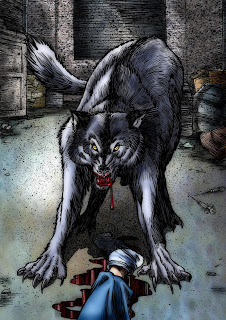 Dramatic artistic representation of a scene from the movie Wolfen (© Richard Svensson)
Dramatic artistic representation of a scene from the movie Wolfen (© Richard Svensson)
November 29, 2020
THE DOBHAR-CHÚ - TRAILING IRELAND'S MYSTERIOUS MASTER OTTER. Part 2: MODERN-DAY ENCOUNTERS?
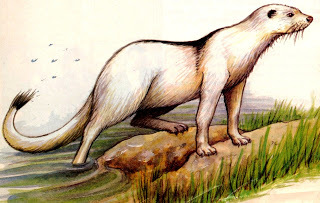 Artistic representation of the dobhar-chú or master otter, based upon traditional Irish folklore (© Philippa Foster)
Artistic representation of the dobhar-chú or master otter, based upon traditional Irish folklore (© Philippa Foster) In Part 1 of this ShukerNature article (click hereto read it), I recalled the traditional lore appertaining to an Irish mystery beast known as the dobhar-chú or master otter, and I also documented a seemingly true but fatal confrontation between one of these supposedly savage, bloodthirsty beasts and a woman on the shore of Glenade Lake in northwestern Ireland's County Leitrim – with the avenging slaughter of the murderous dobhar-chú by her husband actually carved for all to see on her still-existing gravestone in a local cemetery.
This remarkable incident allegedly occurred almost three centuries ago, back in 1722, but as I shall now reveal here in Part 2, encounters with large unidentified creatures in northwestern and western Ireland that bear much more than a passing resemblance to the dobhar-chú have also occurred in modern times – and, indeed, are still doing so.
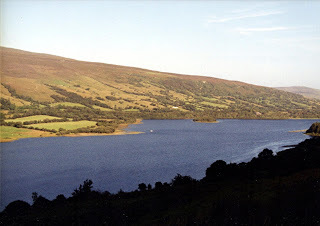 Glenade Lake (© Daev Walsh)
Glenade Lake (© Daev Walsh) The origin of a folk story featuring a bizarre-sounding specimen of dobhar-chú that reputedly sported a long horn on its head like a lutrine unicorn, County Sligo in the Republic of Ireland's northwestern portion is sandwiched between County Leitrim to the right, and County Mayo to the left. Several islands are present off the western coast of Mayo, including Achill (Ireland's largest coastal island, but attached to the mainland by a bridge), whose principal cryptozoological claim to fame is Sraheens (=Glendarry) Lough. This is a small, circular lake, approximately 400 ft in diameter, very windswept and isolated, which is said to be frequented by strange water monsters.
Most of Ireland's aquatic cryptids are of the 'horse-eel' variety – i.e. sinuous eel-like entities but with horse-like heads. The Sraheens Lough monster, however, is apparently very different.
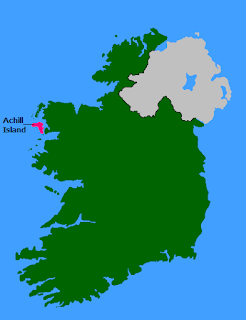 Achill Island (in red) on map of Ireland (© WikiDon/Wikipedia –
CC BY-SA 3.0 licence
)
Achill Island (in red) on map of Ireland (© WikiDon/Wikipedia –
CC BY-SA 3.0 licence
) At around 10 pm on the evening of 1 May 1968, two local men, John Cooney and Michael McNulty, were driving past this lake on their way home when suddenly an extraordinary creature, shiny dark-brown or black in colour and clearly illuminated by their vehicle's headlamps, raced across the road just in front of them and vanished into some dense foliage nearby. They estimated its height at around 2.5 ft and its total length at 8-10 ft, which included a lengthy neck, and a long sturdy tail. It also had a head that they variously likened to a sheep's or a greyhound's, and four well-developed legs, upon which it rocked from side to side as it ran. Needless to say, its fully-formed legs and long tail readily eliminated any possibility that it was a seal that had come ashore onto Achill from the coast. Just a week later, a similar beast crawled out of the lake and climbed the bank as 15-year-old Gay Dever was cycling past, shocking him so much that he dismounted to watch it go by. It seemed to him to be much bigger than a horse, and black in colour, with a sheep-like head, long neck, tail, and four legs (of which the hind ones were the larger). Other sightings were also reported during this period, but the identity of the animal(s) was never ascertained.
In the 13-volume encyclopedia, The Unexplained, edited by Peter Brookesmith, and first published in part-work form during the early 1980s, an unnamed artist's reconstruction of the Sraheens Lough monster originally appeared in an article on Irish lake monsters written by veteran unexplained mysteries chroniclers Janet and Colin Bord but is nowadays readily accessible online. The illustration was based upon the eyewitness accounts given above for this monster, but as can be seen here it also happens to be exceedingly similar to the Conwall gravestone's depiction of the dobhar-chú! Both share a sleek body and powerful hindquarters, long slender tail, lengthy but not overly elongate neck, distinct paws, and relatively small head. Indeed, one could easily be forgiven for assuming that the two illustrations had been based upon the same animal specimen (let alone species). Could such an arresting degree of morphological similarity be nothing more than a coincidence, or is the dobhar-chústill in existence amid the countless lakes of the Emerald Isle?
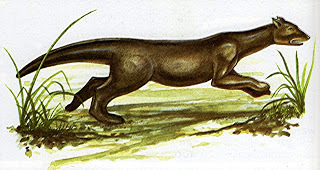 Artistic reconstruction by unnamed artist of the Sraheens Lough monster as sighted by John Cooney and Michael McNulty on 1 May 1968 (© Orbis Publishing – reproduced here on a strictly non-commercial Fair Use basis for educational/review purposes only)
Artistic reconstruction by unnamed artist of the Sraheens Lough monster as sighted by John Cooney and Michael McNulty on 1 May 1968 (© Orbis Publishing – reproduced here on a strictly non-commercial Fair Use basis for educational/review purposes only) Cryptozoological sceptics have pointed out that with a circumference of only 1,200 ft, surely Sraheens Lough is too small to support water monsters of this nature. However, anything capable of running across roads on four sturdy limbs is equally capable of moving from one lake to another, not residing permanently in any one body of water - which could explain why sightings of monsters in Sraheens Lough are sporadic rather than regular.
Some very interesting additional reports of modern-day Irish cryptids resembling giant otters can be found in a fascinating book entitled Mystery Animals of Ireland (2010), authored by longstanding Celtic cryptozoology specialists Gary Cunningham and Ronan Coghlan. For example, some time in 1999-2000 near to Portumna in County Galway (south of County Mayo), Patrick Sullivan from Cleggan, Connemara, was driving along the N65 towards Loughrea when he suddenly saw an unfamiliar-looking animal wandering on the opposite side of the road. Curious to see more of this creature, he was able to turn around and drive back, and later reported that it resembled an otter but was larger and darker. As he watched, it moved off the road and disappeared into some undergrowth. In around 2001, the Sraheens Lough monster reared its otter-like head again, with a new, recent sighting featuring in a debate concerning this mystery beast that was broadcast on Radio na Gaeltachta. But the most significant recent sighting took place during April-May 2003, on Omey Island, in Connemara, County Galway, and featured Waterford artist Sean Corcoran and his wife.
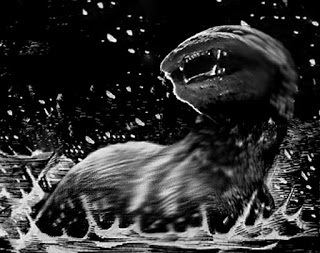 Sean Corcoran's sketch of an alleged dobhar-chu seen by him on Omey Island, County Galway, in 2003 (© Bang Art/Wikipedia–
CC BY-SA 3.0 licence
)
Sean Corcoran's sketch of an alleged dobhar-chu seen by him on Omey Island, County Galway, in 2003 (© Bang Art/Wikipedia–
CC BY-SA 3.0 licence
) In October and November 2009, Sean contacted me to provide me with details of their sighting on this island, and it was also documented by Gary and Ronan in their book. Omey contains two freshwater lakes, and is accessible on foot when the tide is out. Sean and his wife were camping on Omey, near to Fahy Lough, the larger of its two lakes, when at around 3 am one morning they were alerted to a strange yelping cry coming from the sand dunes at the lake's western side. Armed with a torch, they set out to investigate, and encountered just 2-3 yards away an animal described by Sean as being larger than his pet Labrador dog. The creature speedily swam across the lake to its furthest side, where it then emerged, clambered onto a large rock, and reared up onto its hind legs. In this pose, it was estimated by Sean to be around 5 ft tall, and was observed to be dark in overall colour but sporting orange-red flipper-like feet. It then turned away and disappeared into the darkness, leaving Sean and his wife to return to their tent, thoroughly bemused by what they had just seen.
Tellingly, as pointed out by Gary and Ronan in their coverage of this sighting, Fahy Lough is only about 20 yards from the sea at Omey's sheltered western point, with the marine waters around this island being plentifully supplied with available food for such a creature, including fishes and crustaceans. Moreover, during previous camping holidays on Omey, Sean had seen animal scats near Fahy Lough that when examined were found to contain the remains of crabs and other shellfish.
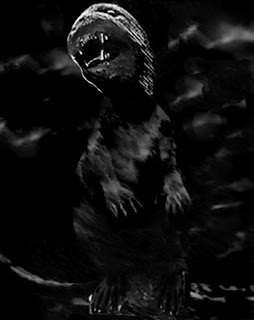 Sean Corcoran's sketch of an alleged dobhar-chu seen by him on Omey Island, County Galway, in 2003 rearing up onto its hind legs (© Bang Art/Wikipedia –
CC BY-SA 3.0 licence
)
Sean Corcoran's sketch of an alleged dobhar-chu seen by him on Omey Island, County Galway, in 2003 rearing up onto its hind legs (© Bang Art/Wikipedia –
CC BY-SA 3.0 licence
) Otters are well known for rearing up onto their hind legs to obtain a better view of something of interest to them, so the Omey beast's behaviour certainly accords with that. However, its size is far bigger than one would expect a normal Irish otter to be, and its orange-red feet (which to give the appearance that they were flippers suggests that they were extensively webbed) are also wholly atypical for the latter.
In view of how near the unidentified beast seen by Sean was to the sea, it is nothing if not interesting to note that a mysterious but rare species referred to locally as a 'sea otter' reputedly once inhabited a large stagnant pool in one of Achill Island's famous seal caves, the cave in question being known as Priest's Hole. This 'sea otter' was said to be distinguished from normal otters by its large size and uniformly black or near-black pelage, broken only by a single white patch on its throat. The source of this information was Harris Stone, an elderly man who was living close by there in around 1906.
 A Eurasian otter standing upright on hind legs (© Holger Uwe Schmitt/Wikipedia –
CC BY-SA 4.0
)
A Eurasian otter standing upright on hind legs (© Holger Uwe Schmitt/Wikipedia –
CC BY-SA 4.0
) Equally intriguing is a large taxiderm otter spotted by Gary Cunningham when visiting an Irish pub in April 1999. The pub is called Hynes Pub, and is situated in the village of Crossmolina, in County Mayo. What attracted Gary's attention to the stuffed otter, placed on top of the pub's television, was not only its size (he estimated it to be about 4.5 ft long), but also its noticeably elongate form, with a remarkably lengthy neck, slightly elongated hinds limbs, long bushy tail (not a typical otter accoutrement!), and its very dark, almost black-coloured fur. Being with his family, Gary did not have the opportunity to gather details concerning the history of this curious specimen, but he was struck by how different it was from the usual Irish otter while comparing surprisingly closely to the appearance of the dobhar-chú carved upon the gravestone of Grace Connolly.
Although he was well aware that morphological distortions can certainly occur during the preparation of taxiderm specimens, having inspected this otter closely Gary was not convinced that its highly distinctive form could be explained away in this manner. He was able to snap two colour photographs of it, which he has most kindly made available to me, enclosing them with a very detailed letter on the subject of Irish water monsters that he wrote to me on 29 May 2000, and as they reveal here it is indisputably unusually elongate in form. Clearly, therefore, it would be beneficial for this enigmatic specimen to be subjected to a formal zoological examination, perhaps even taking from it a small tissue sample for possible DNA analysis, and to enquire from its owners its background history.
 Mystery taxiderm otter at Hynes Pub (© Gary Cunningham)
Mystery taxiderm otter at Hynes Pub (© Gary Cunningham) Mystery beasts reminiscent of the dobhar-chú have even been reported occasionally from northern and northwestern Scotland, although these Caledonian counterparts have attracted much less attention, even from cryptozoologists (but click here to read my earlier ShukerNature article re such beasts). One of the earliest but most intriguing accounts is contained in The History of the Scots From Their First Origin (1575), authored by Hector Boece, which was very kindly brought to my attention by Scottish correspondent Leslie Thomson. The relevant excerpt reads as follows:
...on the summer solstice of the year 1510 some kind of beast the size of a mastiff emerged at dawn from one of those lochs, named Gairloch, having feet like a goose, that without any difficulty knocked down great oak trees with the lashings of its tail. It quickly ran up to the huntsmen and laid low three of them with three blows, the remainder making their escape among the trees. Then, without any hesitation, it immediately returned into the loch. Men think that when this monster appears it portends great evil for the realm, for otherwise it is rarely seen.
Loch Gairloch is a sea loch on Scotland’s northwestern coast; it measures approximately 6 miles long by 1.5 miles wide. As for the creature that emerged from it, I think it safe to assume that its tail’s oak-felling prowess owes more to literary exaggeration than to anatomical accuracy. Conversely, the likening of its feet to those of a goose probably indicated merely that they were webbed. Overall, therefore, the mastiff-sized, web-toed, fleet-footed, quadrupedal water monster of Gairloch does recall the master otter of Glenade Lake, but its taxonomic identity, as with the latter beast’s, remains unresolved.
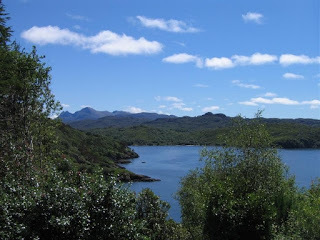 Loch Gairloch (© David Crocker/Wikipedia –
CC BY-SA 2.0 licence
)
Loch Gairloch (© David Crocker/Wikipedia –
CC BY-SA 2.0 licence
) Furthermore, according to Scottish writer Martin Martin, writing in his most famous book, A Description of the Western Isles of Scotland (1703), on the Inner Hebrides island of Skye (where Martin was born):
…the hunters say there is a big otter above the ordinary size, with a white spot on its breast, and this they call the king of otters; it is rarely seen, and very hard to be killed.
Needless to say, this description readily recalls the so-called 'sea otter' with a white spot on its throat reported from the Priest's Hole seal cave on Ireland's Achill Island by Harris Stone just over a century ago.
 Was there – or is there – a white-throated strain of giant 'king' otter in Scotland, equivalent to Ireland's master otter or dobhar-chú, and possibly resembling the saro (see later)? (public domain)
Was there – or is there – a white-throated strain of giant 'king' otter in Scotland, equivalent to Ireland's master otter or dobhar-chú, and possibly resembling the saro (see later)? (public domain) Also of relevance here is Wee Oichie or Oichy, the monster of Loch Oich – which is situated directly below the much larger and more famously monster-associated Loch Ness in the Scottish Highlands, and is 4 miles long. Wee Oichie traditionally sports a flattened head rather than the familiar equine form often noted for Nessie and various other Scottish loch monsters. Having said that, the head of the very big, black, serpentine beast that rose to the surface one summer's day in 1936 was vaguely dog-like, according to A.J. Robertson who spied it while boating at the loch's southwestern end. Certain other eyewitnesses, moreover, including a former loch keeper at Oich interviewed by investigator J.W. Herries during the 1930s, have likened Wee Oichie to a huge otter.
As a river connects Loch Oich to Loch Ness, some researchers have speculated that perhaps Wee Oichie and Nessie are one and the same (always assuming, of course, that they do actually exist!), merely swimming back and forth from one loch to another via this interconnecting river. Indeed, during the mid-1930s, Herries interviewed three eyewitnesses who claimed to have actually observed such an animal journeying via this exact manner from Ness to Oich.
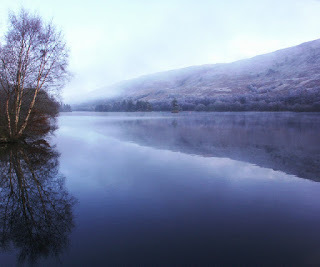 Loch Oich – home to Wee Oichie? (© Claire Pegrum/Wikipedia –
CC BY-SA 2.0 licence
)
Loch Oich – home to Wee Oichie? (© Claire Pegrum/Wikipedia –
CC BY-SA 2.0 licence
) Also greatly deserving of mention here is that one of Britain's most respected zoologists, the late Dr Maurice Burton, speculated in his book The Elusive Monster (1961) that the existence of an undescribed species of giant otter or otter-like creature might indeed help to explain the Loch Ness monster. Although dismissing most Nessie reports as floating algal mats or misidentified known animals, in his book he considered it possible that a small number of reports genuinely featured an undiscovered long-necked lutrine form:
Those who have made a study of otters in the wild know that they are probably the most elusive animal in the countryside. That, at least, is my experience. An otter may work a river near a village and nobody be aware of its presence...
Let us suppose that the habit and habitat of such a long-necked otter-like animal haunting Loch Ness agree with those of the common otter. Then we have to deal with a most elusive beast, hunting mainly inshore, perhaps basking at times at the water's edge, which for long stretches is out of sight except to the person who, very occasionally, takes the trouble to walk along it. Possibly it may go up the rivers and burns, but wherever it may go there are a thousand and one hiding places where even an animal of these proportions could lie hidden, or could move about without exposing itself unduly, especially if it were mainly nocturnal. If we argue that such an animal would be bound to be seen sooner or later, even in so sparsely populated an area - well, that is the kind of frequency with which it has been reported.
Perhaps Burton's most memorable claim was that if a long-necked giant otter (or otter-like beast) did exist, it should not be looked for in the loch itself but on land close by instead: "...in the marshes or on islands (e.g. Cherry Island [a small island on Loch Ness, at Fort Augustus]), up the burns and rivers or along the shores of the loch, although it may also be seen occasionally in the water". How ironic it would be if generations of Nessie seekers have been looking for the LNM in entirely the wrong habitat!
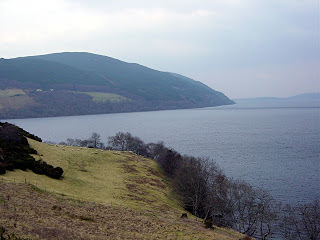 Loch Ness – is this huge expanse of inland water home to an elusive form of extra-large otter? (public domain)
Loch Ness – is this huge expanse of inland water home to an elusive form of extra-large otter? (public domain) Is it possible that some form of super-sized otter really did – and even still does – exist in northwestern and western Ireland (and perhaps in northern and northwestern Scotland too), especially in sheltered, little-frequented areas near to the coast, having long since established its place in traditional folklore while eluding formal scientific discovery? Some Eurasian otters do live along coasts, hunting in seawater, and are indeed sometimes dubbed 'sea otters' by local observers, but they also need regular access to freshwater in order to clean their coat. Perhaps down through the years, some such specimens have attained greater sizes than normal, wholly freshwater individuals, their more remote locations protecting them from the unwelcome attention of hunters, and with their impressive appearance but elusive nature having gradually converted them into a magical, folkloric beast, the dobhar-chú.
In any case, from a purely morphological standpoint extra-large otters are by no means restricted to cryptozoology and mythology. In terms of overall size and weight, the biggest species of otter known to exist today is the sea otter Enhydra lutris. Native to the northern and eastern coasts of the North Pacific Ocean, it measures up to 5 ft long and usually weighs up to 100 lb, but a few exceptional specimens weighing up to 119 lb have been confirmed. Although much lighter than the sea otter, the longest known modern-day species of otter is the South American giant otter or saro Pteronura brasiliensis, which can measure up to 6 ft long, weigh up to 71 lb, and is sometimes referred to as a water dog or even a river wolf. Judging from early descriptions of this species, however, it is possible that a few exceptionally large male individuals formerly existed, growing up to as much as 8 ft long, but hunting probably reduced such specimens' occurrence.
 South American giant otter or saro (© Renaud d'Avout d'Auerstaedt/Wikipedia –
CC BY-SA 2.5 licence
)
South American giant otter or saro (© Renaud d'Avout d'Auerstaedt/Wikipedia –
CC BY-SA 2.5 licence
) Moreover, absolute confirmation that otters can actually attain truly enormous, colossal sizes comes from a gigantic prehistoric species known as the bear otter Enhydriodon dikikae. Named after its huge ursine skull, and inhabiting Ethiopia during the Miocene, this stupendous creature is believed to have weighed around 440 lb. And China's Late Miocene lays claim to a wolf-sized otter called Siamogale melilutra, known from a cranium unearthed at a Yunnan province fossil site and formally described in 2017.
Nevertheless, both of the above-noted living species still share the same overall morphology as other otters (the post-cranial morphology of Enhydriodon and Siamogale are currently unknown), their bodies certainly not resembling a greyhound's, whereas that of the dobhar-chú seemingly does. Consequently, this is a major problem when attempting to reconcile the latter mystery beast with rare sightings of extra-large, coastal-dwelling Eurasian otters.
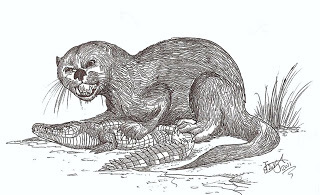 Artistic representation of Ethiopia's prehistoric bear otter Enhydriodon dikikae (© Hodari Nundu)
Artistic representation of Ethiopia's prehistoric bear otter Enhydriodon dikikae (© Hodari Nundu) Judging from the data presented in this article, if the dobhar-chúis a real animal that has been accurately described by eyewitnesses and depicted on the gravestones, then surely it must be taxonomically discrete from the normal Eurasian otter? Moreover, the very sizeable true sea otter Enhydra lutris is an exclusively marine Pacific species that never reaches British or other Atlantic coasts, so this species cannot be involved here either (although, intriguingly, based upon two fossil carnassials uncovered, a related prehistoric species, E. reevei, is known to have existed in East Anglia as recently as the Pleistocene epoch, which ended a mere 11,700 years ago).
Nevertheless, until a specimen is (if ever) obtained, Ireland's mysterious master otter will continue to linger with leprechaun-like evanescence amid the twilight limbo between Celtic folklore and contemporary fact.
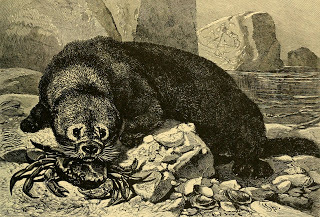 Vintage engraving of a sea otter from 1895 (public domain)
Vintage engraving of a sea otter from 1895 (public domain)
This article is a greatly-expanded, updated version of the dobhar-chú account that appeared in my 2003 book The Beasts That Hide From Man, which in turn was an expanded version of my original 1990s dobhar-chú article that appeared in Strange Magazine.
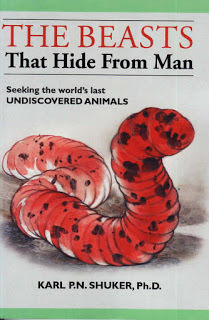 The Beasts That Hide From Man (© Dr Karl Shuker/Paraview Press)
The Beasts That Hide From Man (© Dr Karl Shuker/Paraview Press)
November 27, 2020
THE DOBHAR-CHÚ - TRAILING IRELAND'S MYSTERIOUS MASTER OTTER. Part 1: GLENADE LAKE AND A GRAVESTONE
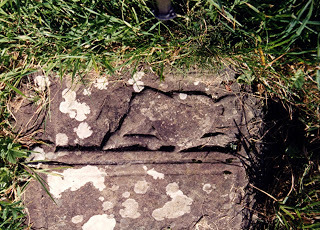 Dobhar-chú carved upon Grace Connolly's tombstone (© Daev Walsh)
Dobhar-chú carved upon Grace Connolly's tombstone (© Daev Walsh) At no more than 39 in long in total length, the Asian small-clawed otter Aonyx (=Amblyonx) cinereus is the world's smallest species of living otter. As a result of how commonly it is exhibited in British zoos, however, it is possibly the most familiar one to many people here – more so, in fact, than our own larger native species, the Eurasian otter Lutra lutra, up to 4 ft long on average (and confirmed maximum length of 4.5 ft), due to the latter's famous elusiveness.
If we turn from zoos and mainstream zoology to the sequestered realm of cryptozoology, however, its archives of eyewitness reports and folkloric traditions indicate that an even bigger and far more formidable otter might also be encountered in the British Isles. This little-known but thoroughly fascinating mystery beast, known as the dobhar-chú and investigated by me for over 20 years now, is the subject of this present two-part Shukeraturearticle, which as far as I am aware is the most detailed documentation of it ever published.
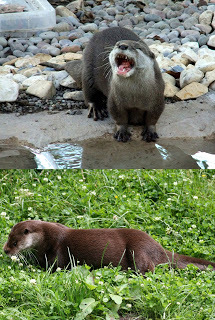 Asian small-clawed otter (© Dr Karl Shuker) / Eurasian otter (public domain)
Asian small-clawed otter (© Dr Karl Shuker) / Eurasian otter (public domain) The dobhar-chú is a supposedly mythical beast from northwestern and western Ireland, is also called the dobarcu, master otter, and king otter, and was classed by English folklorist Dr Katharine Briggs as a prototype animal representing all of its kind there. For Ireland is indeed home to the afore-mentioned Eurasian otter, where it is referred to as the Irish otter, exists at this species' greatest population density anywhere in Europe, and was once deemed to be a separate species in its own right. In The Anatomy of Puck (1959), Briggs termed the dobhar-chú the master otter, and it was evidently larger than normal otters because she stated that it was said to have appeared once at Dhu-Hill, with "...about a hundred common-sized otters" in attendance. According to legend, an inch of the master otter's pelt will prevent a ship from being wrecked, a horse from injury, and a man from being wounded by gunshot or other means.
In Myth, Legend and Romance. An Encyclopaedia of the Irish Folk Tradition(1990), Dr Dáithí ó hÓgáin described it as a large male otter called the king otter, reiterating much of the information presented by Briggs but also noting that it was totally white in colour except for its black ear tips and a black cross upon its back, and that it never slept. Yielding an unexpected parallel with the werewolf legend, this uncanny creature could only be killed with a silver bullet, and its killer would himself die no longer than 24 hours afterwards.
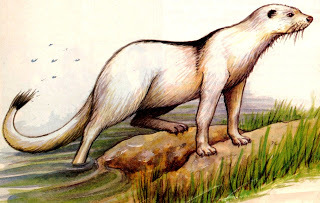 Artistic representation of the dobhar-chú or master otter, based upon traditional Irish folklore (© Philippa Foster)
Artistic representation of the dobhar-chú or master otter, based upon traditional Irish folklore (© Philippa Foster) For quite some time, the relatively sparse details given above were all that I knew concerning the dobhar-chú - but during the mid-1990s fellow British mystery beast researcher Richard Muirhead kindly supplied me with several additional sources of information. These offer a much more extensive, and sinister, insight into Ireland's most mystifying mammal.
The fascinating excerpt presented below is from Roderic O'Flaherty's book A Chorographical Description Of West Or H-lar Connaught (1684), and chronicles an extremely alarming incident that had reputedly taken place approximately 10 years earlier at a very large, deep, 6-mile-long lake in County Mayo, western Ireland, called Lough Mask (=Measca or Measg):
The man was passing the shore just by the waterside, and spyed far off the head of a beast swimming, which he tooke to have been an otter, and tooke no more notice of it; but the beast it seems there lifted up his head, to discern whereabouts the man was; then diving, swom [sic] under water till he struck ground: whereupon he runned [sic] out of the water suddenly, and tooke the man by the elbow, whereby the man stooped down, and the beast fastened his teeth in his pate, and dragged him into the water; where the man tooke hold on a stone by chance in his way, and calling to minde he had a knife in his pocket, tooke it out and gave a thrust of it to the beast, which thereupon got away from him into the lake. The water about him was all bloody, whether from the beast's bloud [sic], or his own, or from both, he knows not. It was of the pitch of an ordinary greyhound, of a black slimy skin, without hair as he immagined [sic]. Old men acquainted with the lake do tell there is such a beast in it, and that a stout fellow with a wolf dog along with him met the like there once; which after a long strugling [sic] went away in spite of the man and dog, and was a long time after found rotten in a rocky cave of the lake, as the water decreased. The like, they say, is seen in other lakes of Ireland, they call it Dovarchu, i.e. a water-dog, or Anchu, which is the same.As the above beast was evidently mammalian in nature, it seems reasonable to assume that it was not actually hairless, instead possessing short fur but which, when wet, adhered so closely to its body that the beast seemed to its human victim to be shiny and hairless. This same optical illusion occurs with otters, mink, and other short-furred aquatic mammals when first emerging from water.
 Alongside a sculpture of a giant otter (© Dr Karl Shuker)
Alongside a sculpture of a giant otter (© Dr Karl Shuker) The following letter, written by Miss L.A. Walkington and published by the journal of the Royal Society of Antiquaries of Ireland in 1896, recalls a second apparently real, violent encounter with a dobhar-chú, but, tragically, there was no happy ending this time:
When on a recent visit to Bundoran [in County Leitrim, northwestern Ireland], we heard a legend concerning a tombstone in the graveyard of Caldwell [Conwall], which induced us to visit the place. The story is as follows:- A young married woman went to wash her clothes in a stream near the house, and an animal called by the natives a dhuraghoo (that is spelled as pronounced, but I have never seen the word written), came out of the river and attacked her. Her husband (or brother according to some accounts) missing her went to look for her, and found her dead and the beast sucking her blood. The dhuraghoo attacked the horse; for the husband seems to have been on horseback. The horse being frightened, ran away, but became exhausted at a village called from this circumstance Garronard ('garron', a bad horse; 'ard', a high place). The dhuraghoo is said to have gone "through" the horse and to have killed it. It was then speared by the husband who at the same time killed its young one. The dhuraghoo is said by some to have been an animal half wolf-dog, half-fish, by others an enormous sea-otter...Two other tombstones are shown in connexion with the story, one bearing an image of the horse, and said to be that of the husband. Perhaps some antiquary may be able to throw light on the legend and on the nature of the dhuraghoo.In a later issue of this journal for 1896, Miss Walkington's letter drew the following response from H. Chichester Hart:
…I have heard at Ballyshannon, a few miles from Bundoran, the following account of the "Dorraghow," as it was pronounced in that district. He was "The King of all the Lakes, and Father of all the Otters. He can run his muzzle through the rocks. He was as big as five or six otters." My informant thought he was long dead.The master otter also appeared in a poem entitled 'The Old House', within a 1950s anthology, Further Poems, by Leitrim poetess Katherine A. Fox. The relevant lines read:
The story told of the dobhar-chu
That out from Glenade lake
Had come one morning years ago
A woman's life to take.
Situated between the Arroo mountains to the east and the Dartry mountains to the west, Glenade Lake (aka Glenade Lough) is roughly 1 mile long, half a mile wide, covers an area of approximately 0.3 square mile, and is home to a wide diversity of freshwater fishes, including pike, perch, roach, and eel, as well as a sizeable crustacean called the white-clawed crayfish. Consequently, it could certainly feed a piscivorous mammal, especially one that may not be resident there, but moves around from one such lake to another (and of which Ireland is very plentifully supplied), as otters are wont to do.
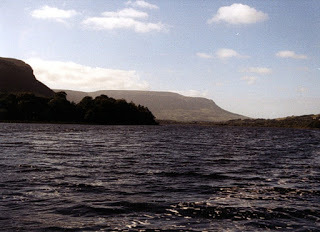 Glenade Lake (© Daev Walsh)
Glenade Lake (© Daev Walsh) During his researches, Richard Muirhead also uncovered a much longer poem, of unverified source (though claimed by some to have been written by a local headmaster). Entitled 'The Dobhar-chú of Glenade', it is devoted entirely to the master otter's deadly attack upon the hapless maiden and its fatal encounter with her vengeful husband. Regrettably, its style is somewhat lurid and turgid, as witnessed by the following excerpt:
She having gone to bathe it seems within its waters clear
And not returning when she might her husband fraught with fear
Hastening to where he her might find when oh, to his surprise.
Her mangled form still bleeding warm lay stretched before his eyes.
Upon her bosom snow white once but now besmeared with gore
The Dobarcu reposing was his surfeitting been o'er.
Her blood and entrails all around tinged with a reddish hue.
"Oh God", he cried, "tis hard to bear but what am I to do".
Shakespeare it ain't, that's for sure! Nevertheless, its 16 verses yield the most detailed version of this story currently known to me (although some of the details contained in it differ from those noted in Miss Walkington's letter), and it is therefore of great value.
It dates the incident as occurring approximately 200 years prior to the poem's composing (the poem itself may date from around 1920), and features a man called Terence McGloughlan who lived close to the shore of Glenade Lake with his wife, Grace Connolly.
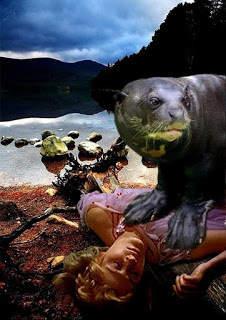 Reconstruction of the master otter's fatal attack upon Grace Connolly (© Randy Merrill)
Reconstruction of the master otter's fatal attack upon Grace Connolly (© Randy Merrill) One bright September morning, Grace visited Glenade Lake to bathe, but when she did not return home Terence retraced her steps, and upon reaching the lake he found her dead body, torn and bloodstained - with her murderous assailant, a dobhar-chú, lying asleep across her bosom. Maddened with grief and rage, Terence raced home for his gun, returned to the scene of the horrific crime and shot his wife's killer dead. In the fleeting moments before it died, however, the dobhar-chú gave voice to a single piercing squeal - which was answered from the depths of the lake. Seconds later, the dead creature's avenging mate surfaced, and Grace's terrified husband fled.
Reaching home, Terence told his neighbours what had happened, and they advised him to flee the area at once. This he did, accompanied by his loyal brother Gilmartin, both riding speedily on horseback, but doggedly pursued by the whistling dobhar-chú. After 20 miles, they reached Castlegarden Hill, dismounted, and placed their horses lengthwise across the path leading into it. Standing nearby, with daggers raised, they awaited the arrival of their shrill-voiced foe - and as it attempted to dash through the horses' limbs, Terence plunged his dagger downwards, burying it up to its hilt within the creature's heart.
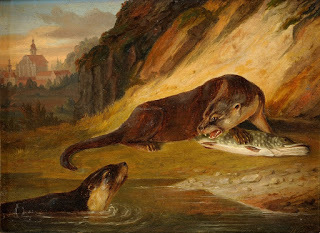 Was Glenade Lake once home to a pair of master otters? (an 1856 otter painting, public domain)
Was Glenade Lake once home to a pair of master otters? (an 1856 otter painting, public domain) Needless to say, it would be easy to dismiss the story of Grace Connolly as nothing more than an interesting item of local folklore - were it not for the existence of two dobhar-chú gravestones, commemorating the above episode. These are documented in an extensive article by Patrick Tohall, published by the journal of the Royal Society of Antiquaries of Ireland in 1948. The first of the two monuments is a gravestone in Congbháil (Conwall) Cemetery in the town of Drumin (Drummans), forming part of the approach to the Valley of Glenade from the coastal plain of north County Leitrim and south County Donegal, and just a few miles south of Kinlough, beside the main road leading from Bundoran to Manorhamilton.
A recumbent flag of sandstone roughly 4.5 ft by 1 ft 10 in and dated 24 September 1722, what makes this the more interesting of the two stones is that it actually portrays the dobhar-chú itself - described by Tohall as follows:
The carved figure is set in a panel about 17.5 ins. by 7 ins. It shows a recumbent animal having body and legs like those of a dog with the characteristic depth of rib and strength of thigh. The tail, long and curved, shows a definite tuft. The rear of the haunch, and still more the tail, are in exceptionally low relief, apparently due to the loss of a thin flake from the face of the slab. So far the description is canine. The paws, however, appear unusually large, while the long, heavy neck and the short head into which it shades off, together with the tiny ears are all like those of an Otter or such Mustelida.
The head and neck are bent backward to lie flat on the animal's backbone. A human right hand, clenched and with fingers facing the spectator, is shown holding a weapon which has entered the base of the neck and reappears below the body in a short stem which suddenly enlarges to finish as a barb.
The article contains a photo of this depiction, taken by society member Dr J.J. Clarke. Unfortunately, in my files' photocopy of Tohall's article, the illustrations had not reproduced well. In autumn 1997, however, after I had communicated with one of my Irish correspondents, Daev Walsh, concerning it, he and a colleague, Joe Harte, independently visited the dobhar-chúgravestone in autumn 1997. Not only were they both able to confirm that it still existed, they also took some excellent photographs of it, which they kindly passed on to me to use in my own writings as I saw fit. These lucidly portray the carved dobhar-chú, revealing that its head is indeed small and somewhat lutrine. Equally, after studying the photos, I agree with Tohall's description of its body as canine - almost greyhound-like, in fact, except for its large paws and lengthy neck.
 Close-up of the dobhar-chú carved upon Grace Connolly's tombstone (© Daev Walsh)
Close-up of the dobhar-chú carved upon Grace Connolly's tombstone (© Daev Walsh) Interestingly, when I showed the pictures of the carved dobhar-chú to various cryptozoological colleagues, some of them mistakenly assumed that the clenched hand of the dobhar-chú's slayer was actually the creature's head! However, it is far too small to be this, and when the photos are viewed closely, the fingers of the clenched hand, which face the camera, can be clearly discerned gripping a spear-like weapon, as can the creature's real head, thrown back across its back. Even the thin line of its mouth is readily visible.
Some of the wording on the gravestone is still legible too, identifying the person buried beneath as Grace Con, wife of Ter MacLoghlin. According to Tohall, she was still spoken of locally, but as Grainne, not Grace, and he also pointed out that Ter is undoubtedly short for Terence, and that it is Gaelic custom for a married woman to retain her maiden name - explaining why Grace was referred to on her gravestone as Con rather than MacLoghlin. Tohall considered it likely that her gravestone was prepared while her death was still fresh in local memory, because similar gravestones in this same cemetery are characteristic of the period 1722 to 1760. This, then, would appear to be the last resting place of the hapless young woman killed by the dobhar-chú, whose own existence is commemorated here too - all of which seemingly elevates the episode from folklore to fact.
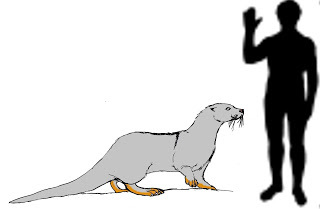 Scale illustration providing an estimate of size for the dobhar-chú alongside an average-sized human (© Connor Lachmanec)
Scale illustration providing an estimate of size for the dobhar-chú alongside an average-sized human (© Connor Lachmanec) As recently as World War I, the second dobhar-chú gravestone, which was that of Grace's husband Terence, was still in the cemetery of Cill Rúisc (Kilroosk), at the southern entrance to Glenade, but had broken into two halves. At some later date, these were apparently placed up onto a boundary wall, and subsequently disappeared. Fortunately, however, at the time of Tohall's researches it was still well-remembered by all of the region's older men, who stated that it depicted some type of animal, and was popularly known as the Dobhar-Chú Stone. When asked whether the animal had resembled a dog, the only person who could recall the creature's appearance stated that it was more like a horse.
Recalling the story of the dobhar-chú in his article, Tohall placed the home of Grace (or Grainne) and her husband in the townland of Creevelea at the northwest corner of Glenade Lake, and (like Miss Walkington, above) stated that Grace visited the lake to wash some clothes (not to bathe, as given in the 16-verse poem). Indeed, several variants of the story exist elsewhere in the general vicinity of Glenade, but Tohall believed that the Conwall gravestone was particularly important - for constituting possibly the only tangible evidence for the reality of the dobhar-chú.
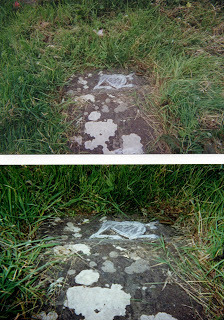 Two views of the dobhar-chú carving (highlighted in white) in situ on Grace Connolly's tombstone (© Joe Harte)
Two views of the dobhar-chú carving (highlighted in white) in situ on Grace Connolly's tombstone (© Joe Harte) Tohall offered some interesting reflections upon the terminology of the master otter's native name. Both in Ireland and in Scotland, ‘dobhar-chú’, which translates as 'water-hound', has two quite different meanings. One is merely an alternative name for the Eurasian otter, but is rarely used in this capacity nowadays (superseded by 'mada-uisge'). The other is the name of a mythical otter-like beast, and is still widely used in this capacity within the County Leitrim region. Tohall reserved the most intriguing insight into the master otter concept, however, for the closing sentence of his article:
The best summary of the idea is set out in the records of the Coimisium le Béaloideas by Sean ó h-Eochaidh, of Teidhlinn, Co. Donegal, in a phrase which he heard in the Gaeltacht: 'the Dobharchú is the seventh cub of the common otter' (mada-uisge): the Dobhar-chú was thus a super otter.Today, the world beyond Glenade and its environs in northwestern and western Ireland seems to have largely forgotten about the dobhar-chúand its sinister deeds. However, it may be premature for cryptozoology to assume that this enigmatic animal is entirely confined to the shadows of the distant past - for it might conceivably have made some unexpected appearances in very recent times too, as will be revealed in Part 2 of this ShukerNature article.
This article is a greatly-expanded, updated version of the dobhar-chú account that appeared in my 2003 book The Beasts That Hide From Man, which in turn was an expanded version of my original 1990s dobhar-chú article that appeared in Strange Magazine.
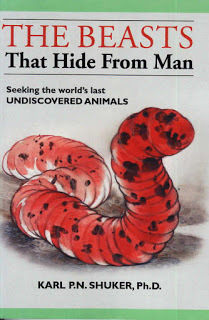 The Beasts That Hide From Man
(© Dr Karl Shuker/Paraview Press)
The Beasts That Hide From Man
(© Dr Karl Shuker/Paraview Press)
November 14, 2020
OVER TO THE ORANG KARDIL – SUMATRA'S 'OTHER' ORANG PENDEK?
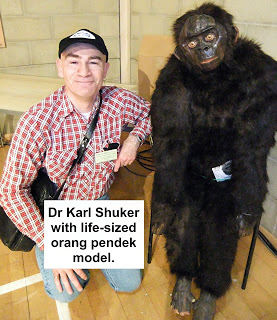 Alongside a life-sized representation of the orang pendek created for the CFZ (© Dr Karl Shuker / CFZ)
Alongside a life-sized representation of the orang pendek created for the CFZ (© Dr Karl Shuker / CFZ) Once upon a long ago in the wonderful world of cryptozoology, only a single type of diminutive Indonesian mystery man-beast was widely reported – the orang pendek ('short man') or sedapa of Sumatra, in this southeast Asian country's Greater Sundas island group, reported by locals and Westerners alike for well over a century. Physically represented by unidentifiable hair samples and wholly distinct footprint casts, this reddish-furred, bipedal, tailless entity is usually said to stand a mere 3-4.5 ft tall.
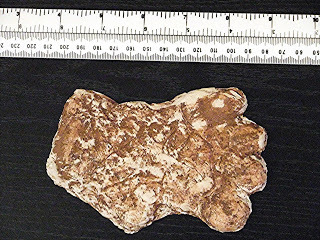 Plaster cast of an alleged orang pendek footprint, revealing its very distinctive form (© Dr Karl Shuker)
Plaster cast of an alleged orang pendek footprint, revealing its very distinctive form (© Dr Karl Shuker) Suggested identities on offer for the orang pendek have ranged from a terrestrial form of orang utan or gibbon to a bona fide human species, possibly even a relict representative of our own species' predecessor, Homo erectus. So far, so simple (relatively speaking).
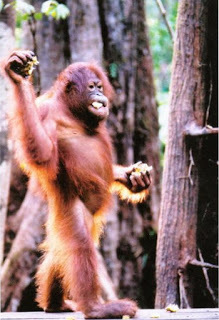 An orang utan standing upright in the wild (©
Tom Low/Wikipedia
– public domain)
An orang utan standing upright in the wild (©
Tom Low/Wikipedia
– public domain) Then in 2003, the first skeletal remains of what, after much contention, is nowadays accepted by most researchers to have been a bona fide diminutive human species (rather than merely stunted, freak Homo sapiens) were found on the small island of Flores in Indonesia's Lesser Sundas group. Formally dubbed Homo floresiensis but known colloquially as Flores Man or the hobbit, it is believed to have only stood around 3.5 ft tall, and to have become extinct at least 50,000 years ago – or did it?
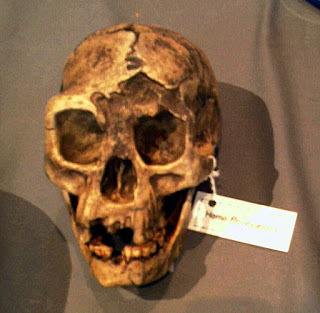 Replica skull of Flores Man aka the hobbit (© Dr Karl Shuker)
Replica skull of Flores Man aka the hobbit (© Dr Karl Shuker) Researchers began hearing native folklore and stories concerning the ebu gogo, described not only as very short human entities but also as still very much alive in the wilder, more remote regions of Flores. If such beings really do exist, might they be living, modern-day representatives of Homo floresiensis? Some cryptozoological investigators have taken this line of speculation even further, by linking Flores Man with the Sumatran orang pendek, even though the latter seems taller and more ape-like, not to mention zoogeographically separate. But then came news of an additional component to the Indonesian man-beast/mini-human mystery that makes matters even more complex and potentially confusing.
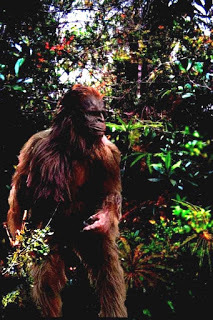 A reconstruction of the orang pendek as a hairy ape-like biped (© Randy Merrill)
A reconstruction of the orang pendek as a hairy ape-like biped (© Randy Merrill) As publicised recently in a number of online articles and reports (click hereto access one of them), Sumatra may also be home to a second, fundamentally different man-beast from the orang pendek, one which, moreover, is very reminiscent of the ebu gogo and, in turn, Flores Man. Known as the orang kardil (aka orang kardill), according to native testimony this entity is definitely some form of human, not ape, hunting aggressively with spears and even deemed to have killed villagers on occasion, but is even shorter in stature than the orang pendek.
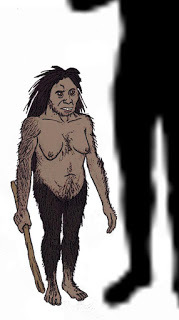 Reconstruction of the possible appearance and stature of the ebu gogo compared with an average human (© Connor Lachmanec)
Reconstruction of the possible appearance and stature of the ebu gogo compared with an average human (© Connor Lachmanec) Consequently, is it possible that a truly miniature Indonesian species of human has existed at one time or another not just on Flores, due to its savage nature has infiltrated traditional Indonesian folklore under various local names such as ebu gogo and orang kardil, and may even still survive today in remote regions of Flores, Sumatra, and perhaps elsewhere in this multi-island country too? All of this is total conjecture, of course, but less than 20 years ago even Flores Man's own existence was entirely unknown to science.
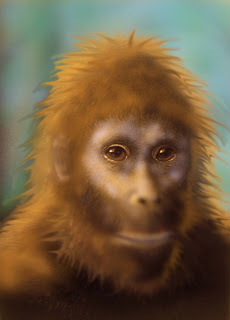 Orang pendek, orang kardil, ebu gogo – are such entities more than just a briefly-glimpsed face in the forest? (© William M. Rebsamen)
Orang pendek, orang kardil, ebu gogo – are such entities more than just a briefly-glimpsed face in the forest? (© William M. Rebsamen)
UPDATE - 14 November 2020
Just a few hours after I uploaded my above article onto ShukerNature and posted links to it in my various Facebook groups, CFZ cryptozoologist Richard Freeman, who has led CFZ expeditions seeking the orang pendek in Sumatra, posted the following fascinating account regarding the orang kardil in my 'Beasts of Legend, Myth & Fantasy' FB group:
"Our late guide Sahar Dimus said that his father and a friend had encountered the Orang-kardill in 1981. The pair had been in a remote part of what is now Kerinci Sablat National Park trading rice for goods in isolated villages. One evening whilst camping in the jungle and cooking rice a tiny man like creature with long hair on the head but a naked body emerged from the rainforest and tried to steal the rice. Sahar's father's friend killed it with a parang (similar to a machete). Then more of the creatures ran out of the forest armed with bamboo spears and killed the man. They did not attack Sahar's father. Sahar said there had been no recent sightings of orang-kardill though there were many of orang-pendek. On my last Sumatran trip a large group of witnesses were gathered in Sahar's village close to Gunung Tuju. All had seen orang-pendek and / or its tracks but none had seen orang-kardill or had heard of any recent sightings. They were quite clear that the two were different."
Thank you so much for making this greatly-welcomed information available, Rich!
October 22, 2020
HERE'S 'MYSTERY CATS OF THE WORLD REVISITED' - AFTER 31 YEARS, MY VERY FIRST BOOK IS BACK, EVEN BIGGER AND BETTER THAN BEFORE!
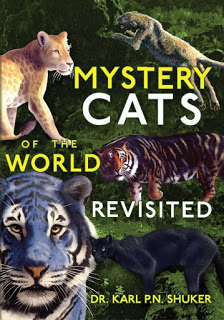 Mystery Cats of the World Revisited
(© Dr Karl Shuker/Anomalist Books/William M. Rebsamen (cover artwork))
Mystery Cats of the World Revisited
(© Dr Karl Shuker/Anomalist Books/William M. Rebsamen (cover artwork)) Published in 1989, Mystery Cats of the Worldwas my very first book, but it swiftly became a classic addition to the cryptozoological literature, lauded by cryptozoologists and mainstream zoologists alike – not to mention a Nobel Prize-winning authoress by the name of Dame Doris Lessing – for what has been described as my scrupulously scientific, objective analysis of the numerous cases documented by me. Even today, it remains not only the undisputed definitive work on mystery cats but also the only one to survey the subject globally. Having been out of print for many years, this book has also become extremely sought-after and highly collectable – but now, three decades since its historic debut, Mystery Cats of the World has finally been republished, as an updated, greatly-expanded new edition aptly retitled Mystery Cats of the World Revisited.
For it not only investigates many new mystery cats but also revisits those previously featured in its 1989 version that in my opinion remain cryptozoological today. Conversely, those that I no longer consider pertinent to the subject have been deleted or dramatically reduced in coverage in order to make way for the dazzling diversity of present-day feline enigmas requiring examination and discussion. Moreover, it also contains many new, rare illustrations, and a substantially enlarged bibliography, plus the truly spectacular front-cover artwork created by esteemed cryptozoological artist and longstanding friend Bill Rebsamen – thanks Bill!
From blue tigers, water leopards, rainbow jaguars, king cheetahs, Transcaucasian daemon cats, and Sumatra's cigau, to spotted lions, black cougars, Mexico's onza, Madagascar's fitoaty, surviving sabre-tooths, feline mega-marsupials, and so much more – the book that set the standard for a whole new generation of cryptozoological writing is back!
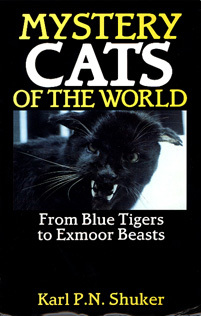 Mystery Cats of the World
– the iconic book that launched my lifelong career as an author and cryptozoological researcher (© Dr Karl Shuker/Robert Hale Limited)
Mystery Cats of the World
– the iconic book that launched my lifelong career as an author and cryptozoological researcher (© Dr Karl Shuker/Robert Hale Limited) Yet how swiftly the intervening years and life itself have flown by. It seems like only yesterday that my little box of six complimentary copies of Mystery Cats of the World, sent to me by its publisher, Robert Hale Limited (now no longer in existence), arrived through the post one sunny morning in June 1989, and how excited my mother Mary Shuker and I were to see them, hold them, browse through them, and later see copies in the shops – my very first book!
How proud once again she would be now to know that it has risen like a veritable feline phoenix 31 years later – my 32nd book in 32 years – and that it will, I hope, be enjoyed by a whole new generation of readers, not to mention my loyal, ever-expanding, ever-faithful following, some of whom date back with me right to the early 1980s and my debut within the cryptozoological community. God bless you, Mom, how I wish that you were still here to share this day, and all days, with me.
Mystery Cats of the World Revisited can be purchased from Amazon.co.ukin the UK, from Amazon.comin the USA, as well as from numerous other online bookstores and directly from its publisher Anomalist Books. It can also be ordered at all good high street bookstores. Finally, please click herefor more details concerning this latest book of mine on its dedicated page on my website.
 The full cover for Mystery Cats of the World Revisited, whose alternate yellow and white front-cover text pays faithful homage to the elegant front-cover style of its illustrious predecessor (© Dr Karl Shuker/Anomalist Books/William M. Rebsamen (cover artwork))
The full cover for Mystery Cats of the World Revisited, whose alternate yellow and white front-cover text pays faithful homage to the elegant front-cover style of its illustrious predecessor (© Dr Karl Shuker/Anomalist Books/William M. Rebsamen (cover artwork))
October 16, 2020
WHEN I INTERVIEWED MARK CHORVINSKY - REMEMBERING A MUCH-MISSED FORTEAN AND FRIEND
 Mark Chorvinsky (© Mark Chorvinsky – photograph specifically made available to me by Mark for inclusion in this interview)
Mark Chorvinsky (© Mark Chorvinsky – photograph specifically made available to me by Mark for inclusion in this interview) During the early years of my cryptozoological research and writing career, one of the most influential figures to provide me with constant encouragement, soon becoming one of my best friends too, was Maryland-based Mark Chorvinsky. Not only a fellow Fortean investigator, Mark was also a well-respected cinematic special effects specialist, stage magician, and founder/publisher of Strange Magazine – whose pages contained some of the most comprehensive and intelligent research into mysterious phenomena of many kinds, including unexplained beasts, that has ever been committed to print. Consequently, I was both delighted and extremely honoured when, after having already published in Strange Magazinea number of detailed articles by me on various cryptozoological subjects, Mark offered me the opportunity to pen a regular column too, 'The Menagerie of Mystery', which soon blossomed into a major multi-page feature in each issue.
By the late 1990s, I was writing articles for a number of publications both in the USA and in my native U.K., including a British partwork entitled The X Factor, devoted to mysteries of many kinds (and therefore totally unrelated to a certain TV talent show for upcoming pop stars that would be screened some years later!). As it had already published some interviews that I had conducted with various notable figures in the worlds of the unexplained and Forteana, I decided to conduct one with Mark, which, with his permission, I then sent off to The X Factor, where it was duly accepted for future publication. Sadly, however, The X Factor came to the end of its run before it was able to publish my interview with Mark, but I retained the original transcript.
Tragically, after having being stricken with cancer, Mark passed away in 2005, aged just 51, a terrible loss to his family, his friends (of whom I am very proud to have been one), and to the entire Fortean world. Mark has rightly been called a Renaissance Man, because he did indeed possess extraordinary talents in a vast range of fields, and his countless contributions in so many varied subjects are still and always will be remembered. Recently, I found the printed-out transcript of my interview with Mark on file, so now, in a ShukerNature world-exclusive, I am publishing it here, as my tribute to a truly remarkable man and one of the kindest, most supportive friends I have ever known, or am ever likely to. God speed, Mark, and thank you for so much, for so long.
MY INTERVIEW WITH MARK CHORVINSKY, DECEMBER 1997
Mark Chorvinsky is one of America's most renowned Fortean investigators, and an expert in cinematic special effects, thus enabling him to conduct professional, significant analyses upon purported photographic evidence for mysterious phenomena. He is also the editor of Strange Magazine, published twice-yearly in the U.S.A. (P.O. Box 2246, Rockville, MD 20847), which is well-respected worldwide for its meticulously-researched articles, and also has an award-winning website (at www.strangemag.com). Here, in a rare interview, Mark talks exclusively to The X Factor concerning some of his many, diverse fields of Fortean study.
Q1: How did you become involved in what must surely be your most unusual current area of research, investigating alleged encounters with the Angel of Death (aka the Grim Reaper)?
A1: I was writing a column for the American magazine Fate, and from time to time I discussed weird encounters that readers had shared with me. One correspondent of mine described an encounter with a hooded, robed figure. When I wrote about this case, I received a good deal of mail from people who had also seen such a figure. A number of the cases involved an entity that we know of as the Angel of Death or the Grim Reaper. The figure often carries a scythe, has a skeletal appearance, and is associated with a death in some manner.
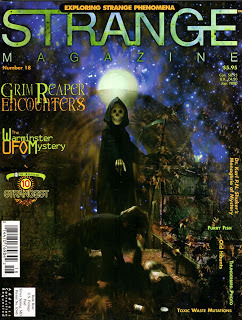 Strange Magazine
#18, depicting the Grim Reaper on its front cover and containing Mark's in-depth investigation of this uncanny subject (© Mark Chorvinsky/Strange Magazine – reproduced here on a strictly non-commercial Fair Use basis for educational/review purposes only)
Strange Magazine
#18, depicting the Grim Reaper on its front cover and containing Mark's in-depth investigation of this uncanny subject (© Mark Chorvinsky/Strange Magazine – reproduced here on a strictly non-commercial Fair Use basis for educational/review purposes only) I have studied this phenomenon for some years now, and find it fascinating, as it was not previously known in the field of the study of Forteana/strange phenomena that there was a Reaper Phenomenon. Consequently, although the motif is centuries old, most of us never thought that it was anything but a cultural image. Who knew, for example, that nurses occasionally see the Grim Reaper at the bedside of a dying patient? I am collecting accounts of Grim Reaper sightings and am working on a book on the subject. I will also be speaking about it at the Fortean Times Unconvention in London in April 1998. If any X Factor readers have had any encounters with a Reaper-like entity, I would like to hear from them [Mark can be reached at strange1@strangemag.com].
Q2: As a renowned bigfoot researcher and special effects authority, what is your opinion concerning the Patterson bigfoot film footage?
A2: Since 1958, bigfoot has become a part of the American cultural landscape, cemented by the film taken by rodeo rider Roger Patterson in 1967. After investigating this film for many years, I must say that the facts point to the hoax hypothesis. There are too many problems with the film for it to be genuine. Primate experts have major problems with the creature's anatomy, and Patterson was under tremendous pressure to come up with something on film. In fact, there was a warrant out for his arrest for non-payment on his rented camera!
 Patterson–Gimlin bigfoot film, frame 352 (current © owner unknown to me – reproduced here in low-resolution format on a strictly non-commercial Fair Use basis for educational/review purposes only)
Patterson–Gimlin bigfoot film, frame 352 (current © owner unknown to me – reproduced here in low-resolution format on a strictly non-commercial Fair Use basis for educational/review purposes only) Investigations by bigfoot investigator Peter Byrne have clearly demonstrated that the film could not have been taken at the time that Patterson claims it was. Why lie about the date and/or time if everything is on the level? The location of the Patterson film is Bluff Creek, California, which has been the site of various bigfoot hoaxes in the past, including the highly tainted 'Birth of Bigfoot' case. Also, there are many rumours of a person in a suit, all of which I am currently investigating. The most prominent of these rumours is that Hollywood make-up artist John Chambers, who worked on the film 'Planet of the Apes', made the Patterson suit. I personally feel that there are many reasons to think this may be true, including the fact that some of Chambers's closest associates believe that he made the suit. Chambers denies involvement, but to my mind there is growing evidence to the contrary, both on and off the record.
Q3: One of the most famous figures of legend that may have actually existed is the Arthurian arch-mage, Merlin. Based upon your own findings, what conclusions have you drawn regarding the erstwhile reality (or otherwise) of Merlin?
A3: One cannot conclude anything definitive about Merlin: to paraphrase San Marte: "Merlin comes to meet us as if from a fog." The fog is a thick mist that has accumulated in the 13 centuries that have passed since Merlin may have lived. However, I feel from my 22 years of research into this subject that there probably was a Merlin, or Myrddin as he is referred to in Welsh, and that he should be afforded a rightful place in early British history.
In recent years, there has been a movement in the direction of accepting the historical reality of Merlin, but the Merlin that is being discussed has been stripped of his magical aspects and turned by rationalists into a Northern bard. I have done extensive research at the British Library, the National Library of Wales, in local libraries throughout Wales, and on location in the major Merlinian locales. Merlin was most certainly a druid-bard and was adviser/prognosticator for a number of heads of state in the fifth and sixth centuries.
 Vintage depiction of Merlin carrying the infant who would become King Arthur (public domain)
Vintage depiction of Merlin carrying the infant who would become King Arthur (public domain) Certainly, if such personages as Arthur, Vortigern, Hengist, and Horsa are accepted as historical figures, then Merlin should not be excluded, since he is mentioned in a number of early British manuscripts in a context that clearly depicts him as a real person of some importance. In the Annales Cambriae, the Welsh Annals, there is an entry for the year 573 AD stating that Merlin went insane at the battle of Arderydd (Arthuret). There is corroboration for the approximate date and the event, and we know the historical context for the battle. Thus, we accept everything in this entry except for Merlin, who is excluded out of an academic prejudice against things magical, anomalous, Fortean. Merlin has been excluded from history just as many Fortean phenomena are excluded from science due to aspects of their existence that do not easily fall into today's scientific fashions. I consider my study of Merlin to be my life's work, and I hope to spend some time in Wales working on a biography of Merlin based on everything that we know about him from all sources.
Q4: Since its inception in 1987, Strange Magazine has deservedly become one of the world's most widely-respected Fortean publications. As its editor and publisher, what do you personally consider to be its single greatest achievement?
A4: Strange Magazine's greatest achievement is following through on its policy of undertaking in-depth investigations into various strange phenomena. My feeling is that Fortean studies have traditionally been at their weakest when it came to actual investigations. Without serious, objective investigation, we will get nowhere in this field.
Most investigators are either believers or disbelievers, but neither of these groups is usually objective, despite their (often transparent) claims to the contrary. While there are occasional exceptions, most believers use their investigation to try to prove the existence of their favourite phenomenon. The disbelievers, meanwhile, are generally using the facts of their investigations to disprove the existence of the phenomenon that they disbelieve in.
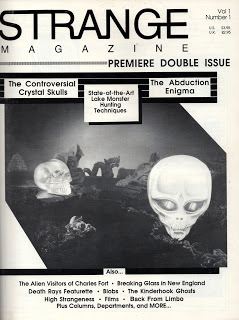 Front cover of the very first issue of Strange Magazine, published in 1987 (© Mark Chorvinsky/Strange Magazine – reproduced here on a strictly non-commercial Fair Use basis for educational/review purposes only)
Front cover of the very first issue of Strange Magazine, published in 1987 (© Mark Chorvinsky/Strange Magazine – reproduced here on a strictly non-commercial Fair Use basis for educational/review purposes only) When we investigate a case for Strange, we are often able to add a good deal of significant information to the field, and in some cases a conclusion is reached. Investigations are difficult, expensive, and time-consuming. They are also often thankless, as many people would rather hear the myth than the reality behind it. We are rather tough investigators, in the sense that we like to leave few if any stones unturned. There is no room for credulity in Fortean investigations, but one should not have a closed mind about strange possibilities either.
Q5: One of your most well-known, and tenacious, research pursuits is seeking the elusive thunderbird photograph. Bearing in mind, however, that it has evaded discovery for many years, how likely do you think it is that this picture really does (or did) exist?
A5: I think that it most likely does not exist, but if it does not there is still much to be learned from the phenomenon of a missing photo that so many credible witnesses believe they have seen. For those who are unfamiliar with it, the thunderbird photograph is a missing photograph that many have described as variously depicting an exceptionally large bird or pterodactyl, with outstretched wings across a barn and a number of cowboys or professor-type figures standing in front of it. The photo was alleged to have been published in Arizona's Tombstone Epitaphnewspaper in 1886, but this has been disproven.
Many of my Fortean friends and colleagues, including Mark Opsasnick, David Robbins, David Walley, and the late Vincent Gaddis, all are absolutely certain that they have seen the photograph, and these are not people prone to wild first-person claims. Why would so many people be certain that they saw it if they did not? But on the other hand, if the photo does not exist, how valuable are first-person accounts, which are the foundation for the widespread belief in many phenomena? If the t-bird photo is merely a false memory, how many other recollections of various phenomena are too?
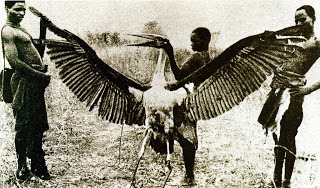 Widely disseminated photograph of a marabou stork that may have inspired some false memories of having seen the thunderbird photograph (public domain)
Widely disseminated photograph of a marabou stork that may have inspired some false memories of having seen the thunderbird photograph (public domain) My current investigation into this case involves magazine and newspaper research at the Library of Congress in Washington, D.C., a study of reports and alleged sightings of supposed thunderbirds and living pterodactyls, and an attempt to list and compare all known recollections of the location of the thunderbird photograph. At least once a week someone contacts me concerning their recollection of the photograph. So far, none of the leads has panned out, but it is a fun search as it is very different from my other endeavours. It would be great if someone found the photo, but it would have to be provided in a verifiable context - such a photo would not be difficult to fake today. In fact, there have been several very lame attempts in that direction. Luckily, our staff at Strange Magazine is very film/video/photography savvy as we are all film-makers/cinematographers/photographers, and have all worked on special effects for film and television.
I predicted a while ago that the thunderbird photo would be one of the top mysteries of the immediate future, which it now is, and I think that we will still be talking about it into the next millennium.
Q6: Looking to the future, as a major figure in Fortean research what do you see as your greatest challenge?
A6: My greatest personal challenge is to keep all of the balls in the air at the same time. At any given time, I am in the midst of a dozen on-going investigations and a number of articles and books, and there is always another issue of Strange Magazineto put out right around the corner. I would like to see all of the classic Fortean cases investigated, and all of the information gleaned put into print without regard as to whether or not the data supports any particular hypothesis. Most of the better-known phenomena are constructed like houses of cards that quickly fall apart when subjected to the weight of close, impartial scrutiny.
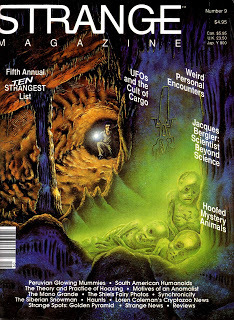 My favourite Strange Magazine front cover (Strange Magazine #9), depicting the mysterious glowing mummies of Peru (© Mark Chorvinsky/Strange Magazine – reproduced here on a strictly non-commercial Fair Use basis for educational/review purposes only)
My favourite Strange Magazine front cover (Strange Magazine #9), depicting the mysterious glowing mummies of Peru (© Mark Chorvinsky/Strange Magazine – reproduced here on a strictly non-commercial Fair Use basis for educational/review purposes only) One of my goals is to train other people to do what I do and to have them work in their respective regions. I have started doing this over the past few years, but with mixed results. The biggest problem is that some investigators are approaching a given case as if there is little chance of hoaxing and a great chance that the phenomenon is "real". In fact, the opposite has turned out to be true in many of the cases that we have investigated. While there are certainly some notable exceptions, most cases have proved to be hoaxes or misidentifications of some kind.
Certainly, with film and photo cases, the vast majority are hoaxes - indeed, it is more probable that a film or photo is a hoax than not. This does not necessarily mean, of course, that any phenomenon that is the subject of hoax films and photos cannot be real itself (i.e. there may be, for example, a fake photo of a sea monster, but this does not rule out the possibility that sea monsters do exist). However, it does imply that the investigator should be prepared to look for red flags and ask the right questions, and to reserve judgement until enough information is in for a conclusion, tentative or not, to be drawn. There are many Fortean investigators in films and on TV, but there are very few in real life. It is hard to be sceptical and to retain a Fortean sense of wonder tempered by investigative experience.
My other great challenge is to get our archives in order, as we have newspaper clippings and personal accounts that have been sent in from all over the world. Data is both the love and the bane of the Fortean researcher.
BOX FEATURE QUESTIONS
Q1: North America lays claim to numerous water monsters, so why do you consider Chessie - the sea serpent of Chesapeake Bay - to be of particular interest?
A1: Chessie is of interest to me largely for selfish reasons - it is the closest alleged sea serpent to where I live in Maryland. I can drive for an hour or so and be in Chessie territory. I enjoy studying Chessie because most of its reports are not known to Forteans or cryptozoologists, and because Chesapeake Bay presents an interesting zoological situation. The bay is partly fresh and partly salty water - thus there is a great array of creatures that live in or find their way into here. Some of them might be mistaken for monsters, and many are in fact quite unusual.
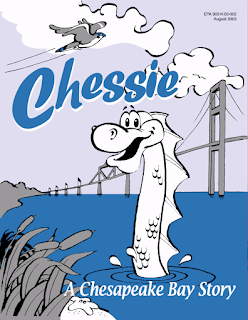 Chessie colouring book published by the U.S. Fish and Wildlife Service in 1986 (public domain)
Chessie colouring book published by the U.S. Fish and Wildlife Service in 1986 (public domain) There have been a considerable number of accounts describing close sightings of a giant eel, but some sightings are of a classic Nessie-esque plesiosaur-type form. Chesapeake Bay is the largest estuary in the United States and is connected to the Atlantic Ocean. Whales, tremendous leatherback and green turtles, porpoises, manatees, giant rays, sharks, huge sturgeon, and lots of eels live in or have made it into the bay. Consequently, if there are such things as sea serpents, perhaps they have made their way into - and back out of - the bay too.
There are also a lot of wild but fascinating accounts of Army experimentation at the Aberdeen Proving Ground, including the area near Pooles Island, on the Chesapeake River. In this restricted area, very bizarre fish and other strange creatures have been sighted.
I was surprised to see a very old map of the United States in the National Museum of Wales's Welsh Folk Museum in St. Fagans. On this map, and heading straight for the Chesapeake Bay, is a sea serpent fitting Chessie's description! Chessie is a world-class mystery creature(s) but understudied, and is therefore very deserving of attention.
Q2: There has been much renewed interest lately concerning the crystal skulls. As a longstanding investigator of these enigmatic artefacts, what is your view as to their origin and possible authenticity?
A2: The crystal skulls were the objects of my first full-blown investigation, and I still find them amazing artefacts, despite the fact that so much myth surrounds them. Whereas the most famous example, the Mitchell-Hedges skull, is of highly questionable origin, the British Museum skull appears to have come from Mexico or Central America. There have always been a number of smaller skulls that are in various collections, including those of the British Museum and the Smithsonian Institution; but while my investigation was in full swing, there were only two known, confirmed, life-size quartz crystal skulls.
 The late Anna Mitchell-Hedges with the Mitchell-Hedges crystal skull that she allegedly discovered (© Mark Chorvinsky)
The late Anna Mitchell-Hedges with the Mitchell-Hedges crystal skull that she allegedly discovered (© Mark Chorvinsky) In recent years, however, there has been a sudden proliferation of crystal skulls. These newer entries in the field appear to a veteran crystal skull student like me to be very different from the "classic" crystal skulls, and may well be modern in origin. There is nothing to stop any lapidary expert from carving a crystal skull from a large piece of quartz. Frank Dorland, who had the Mitchell-Hedges skull in his possession for several years, told me that he could create a duplicate of the Mitchell-Hedges Skull in under a year.
Some academics have suggested that there is a crystal skull "factory" somewhere in Europe, and that the skulls are originating from there. This is supported by the fact that occasionally someone comes to the Readers' Room at the Museum of Mankind in London and asks about a crystal skull of European origin that they have in their possession. The recent New Mexican skull turned out to be a fake - the sculptor came forward after the skull was being taken too seriously.
One thing is for certain - the crystal skulls are very attractive objects with a great deal of lore attached to them. We may never know their true origins, and they will forever be items of mystery.
 Nowadays, there are indeed numerous mass-produced crystal skulls in existence, which do not exhibit anything remotely approaching the extreme craftsmanship of the famous earlier ones investigated by Mark. Here is one such modern-day example: (© Dr Karl Shuker)
Nowadays, there are indeed numerous mass-produced crystal skulls in existence, which do not exhibit anything remotely approaching the extreme craftsmanship of the famous earlier ones investigated by Mark. Here is one such modern-day example: (© Dr Karl Shuker)
October 12, 2020
EXPOSING A TRULY BATTY EXAMPLE OF A FAKE THUNDERBIRD PHOTOGRAPH
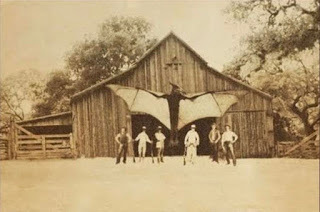 The fake thunderbird photograph exposed in this present ShukerNature article (photo-manipulator(s) unknown to me – reproduced here on a strictly non-commercial Fair Use basis for educational/review purposes only)
The fake thunderbird photograph exposed in this present ShukerNature article (photo-manipulator(s) unknown to me – reproduced here on a strictly non-commercial Fair Use basis for educational/review purposes only) The case of the missing thunderbird photograph is unquestionably one of the most tantalizing – and tormenting – cryptozoological cases on file. I have already documented it in detail hereon ShukerNature as well as in my two prehistoric survivors books, which should all be consulted for comprehensive coverage. However, serving to set the scene for this present article's subject, here is a concise quote from my afore-mentioned ShukerNature account of this elusive (or illusive?) image:
It all (allegedly) began back in 1886, when an Arizona newspaper called the Tombstone Epitaphsupposedly published a very striking photograph, which depicted a huge dead pterodactyl-like bird with open beak and enormous outstretched wings, nailed to a barn and flanked by some men. This bird was reputed to be a thunderbird, and judging from the size scale provided by the height of the men standing alongside it, its wingspan appeared to be an awesome 36 ft! In other words, it was three times greater than that of the wandering albatross Diomedea exulans - the bird species currently holding the record for the world's biggest modern-day wingspan.
Since then, countless people claim to have seen this same photo in various magazines published some time during the 1960s or early 1970s, but no-one can remember precisely where. Those publications thought to be likely sources of such a picture include Saga, True, Argosy, and various of the many Western-type magazines in existence during this period in America, but searches through runs of these publications have failed to uncover any evidence of it.
Nor has anyone come forward with a copy of this photo as published elsewhere, and the archives of the Tombstone Epitaph do not have any copy of it either.
A number of photos claimed to be this evanescent, iconic image have been aired over the years, especially online, but these have all been exposed as hoaxes.
I should also point out here that some people have claimed that the ostensibly-vanished photo seen by them actually portrayed a bona fide pterodactyl, not merely a pterodactyl-like bird. However, just a few years after the thunderbird photo was supposedly first published, another story of a huge winged wonder began circulating, and in the same geographical region. This one concerned a huge bona fide pterodactyl having been shot in an American desert, i.e. a totally separate storyline but which has subsequently been conflated with the missing thunderbird photo's storyline, especially in online accounts. Consequently, this may explain those eyewitness reports of having seen a photo of a dead pterodactyl, rather than of a dead bird, pinned with wings outstretched to a barn door.
As will be seen if you search my ShukerNature blog, I have personally exposed a number of hoax thunderbird photos, because I feel that it is very necessary to remove from further consideration such fakes, as they serve only to confuse and detract from serious investigations being made by various researchers (myself included) regarding the original, genuine thunderbird photograph, if indeed such a picture really does exist. And now, yet another fake thunderbird photo has emerged, but one that I was able to expose very quickly, as now fully revealed here.
During the early hours of yesterday morning (12 October 2020), longstanding Facebook friend Randi MacDonald (aka Randi Mosasaur) brought to my attention via a private message on FB the following photograph that she had found on Pinterest, but with no details concerning its origin. I reproduced it at the opening of this present ShukerNature article of mine, but here it is again:
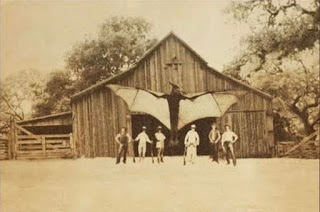 The fake thunderbird photograph found on Pinterest by Randi (photo manipulator(s) unknown to me – reproduced here on a strictly non-commercial Fair Use basis for educational/review purposes only)
The fake thunderbird photograph found on Pinterest by Randi (photo manipulator(s) unknown to me – reproduced here on a strictly non-commercial Fair Use basis for educational/review purposes only) As seen, it has the outward appearance of being a very old, sepia photograph depicting what looks initially like a dead pterodactylian pterosaur pinned with wings outstretched to the front of a barn, in front of which are standing a number of human figures that may conceivably be cowboys or soldiers, or some of each. In short, it closely matches verbal descriptions that have been given by those people claiming to have seen the original, missing thunderbird photograph but alleging that the creature in question was a pterodactyl or at least a pterodactyl-like entity rather than an unequivocal (albeit extremely large!) feathered bird.
However, even the most cursory of glances at this photograph revealed straight away to me that it was a hoax, due to the unambiguously fraudulent nature of the thunderbird portrayed in it. Even if we choose to ignore the scarcely inconsiderable fact that the most recent pterodactyls known from the current fossil record are at least 65 million years old, with no scientifically-confirmed modern-day living example known, thereby rendering as decidedly remote the likelihood of the thunderbird in this photo being genuine, the latter entity is instantly recognizable as a fake, because of its readily visible composite nature. For whereas it sports the crested, beaked head of a Pteranodon-like pterodactyl, the bone structure of its wings as seen through the wing membranes is diagnostically that of a bat!
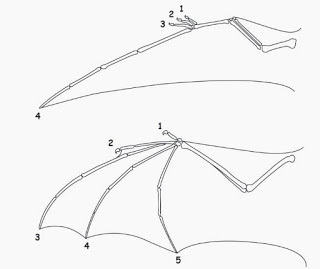 Pterosaur wing's bone structure (top) and bat wing's bone structure (bottom) (© National Geographic – reproduced here on a strictly non-commercial Fair Use basis for educational/review purposes only)
Pterosaur wing's bone structure (top) and bat wing's bone structure (bottom) (© National Geographic – reproduced here on a strictly non-commercial Fair Use basis for educational/review purposes only) As shown above, a pterosaur's wing only contains a single greatly elongated finger, the 4th, which runs along its outer edge within the wing membrane. Conversely, a bat's wing contains three greatly elongated fingers. These are the 3rd, which runs along its outer edge within the wing membrane, plus the 4th and the 5th, both of which are contained further down within the wing membrane. In addition, the less elongated 2nd finger is contained within the wing membrane above the 3rd finger. This bat wing structure is precisely the version exhibited by the fake thunderbird's wings.
Yet even though within just a few moments of having first seen it I knew categorically that this photo was a fake, I decided to see out of sheer curiosity whether I could uncover the major original components in it that had been utilized and converted via digital manipulation to yield its image. I began with the barn, and using a combination of search engines I soon discovered the original, unmodified barn photograph that had been used. A full-colour modern-day photo, it appears on numerous websites, of which the earliest that I could find was in a 11 August 2010 post by Texas-based photographer Nancy Wingo Ridley (username = Rustic Images) on the Foundmyself website (please click hereto access its site), being one of numerous attractive countryside-themed photographs that this website offers for sale. Please click here to see this photo on the Foundmyself site (where it is described as "Old barn and wagon near Fredricksburg, Tx"); and please click here to see Nancy's Foundmyself page containing her many exquisitely beautiful photographs that are available on this site.
When I compared this genuine full-colour modern-day photo of a barn with the fake thunderbird photo, it was immediately evident that the former had been used by the faker as the basis of the latter, as can be seen here:
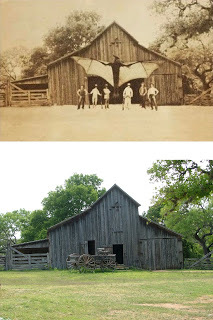 Comparison of the fake thunderbird photograph (top) with the genuine full-colour modern-day photo of a barn (bottom) that was digitally manipulated by person(s) unknown to help create the fake thunderbird photo (creator(s) of fake thunderbird photo unknown to me / (© Rustic Photos – reproduced here in low-resolution format on a strictly non-commercial Fair Use basis for educational/review purposes only; please click
here
to visit the excellent Rustic Photos page of images where the original full-colour barn photograph is just one of numerous beautiful countryside-themed pictures produced by her that can be purchased)
Comparison of the fake thunderbird photograph (top) with the genuine full-colour modern-day photo of a barn (bottom) that was digitally manipulated by person(s) unknown to help create the fake thunderbird photo (creator(s) of fake thunderbird photo unknown to me / (© Rustic Photos – reproduced here in low-resolution format on a strictly non-commercial Fair Use basis for educational/review purposes only; please click
here
to visit the excellent Rustic Photos page of images where the original full-colour barn photograph is just one of numerous beautiful countryside-themed pictures produced by her that can be purchased) As can also be seen, only three major changes have been made via digital manipulation to the actual structure of the barn. The barn door has been widened, the wheeled contraption in front of it has been removed, and the triangular section on the lower right-hand side of the barn roof has been digitally raised, i.e. stretched vertically, so that its outer edge is now tucked just underneath that of the barn roof's upper right-hand side. The effect of this is to make the barn horizontally wider at that particular point – but why would the faker choose to do this? The answer is quite simple – to make the barn wide enough at that particular point for the right-hand wingtip of the wings-outstretched pterodactyl to fit fully on it and thereby match the descriptions of claimed eyewitnesses of the original missing thunderbird photo. Had the faker not done this and had simply used the original full-colour barn photo unmodified, the pterodactyl's right-hand wingtip would have projected quite a way over the edge of the barn roof's lower right-hand edge instead of being contained entirely within it.
Added to the very decent job that the faker has done in converting the modern-day colour barn photo into an aged-looking, purposefully slightly blurry, sepia-tinted photo that one might indeed assume to be 150-or-so years old (as the original, missing thunderbird photo will be by now if it truly exists), this digital widening of the barn in order to make the pterodactyl fit upon it was, I felt, was a clever, well thought-out additional modification of the original full-colour barn photograph – or it would have been, were it not for one massive oversight that again instantly exposed the thunderbird photo to me as a hoax.
Enlarge the two photos, look at the trees surrounding the barn in the original full-colour barn photo, then look at them surrounding the barn in the thunderbird photo. As you will see, they are not just similar, they are identical in every way – every leaf, every twig, every angle of foliage in the original full-colour barn photo is duplicated exactly in the thunderbird photo! An exact match in every way.
One can only assume that either the faker had been careless and had not thought to modify digitally the trees and their foliage in the thunderbird photo so that they were visually distinct from those in the original barn photo, or had chosen simply to ignore this aspect of the photos in the hope that their identical nature would not be spotted (or perhaps the faker did try but found the process too difficult, so decided to leave this aspect alone?).
How long has this fake thunderbird photo been in existence? By using a combination of different search engines once again, the earliest instance of its presence online that I could find was 27 March 2017, on the website tunepk.me (but a link to it no longer operates), which was thrown up by the search engine TinEye. Here is a screenshot of that latter result:
 Earliest search result for the fake thunderbird photo discovered by me, thrown up by TinEye (© TinEye – reproduced here on a strictly non-commercial Fair Use basis for educational/review purposes only)
Earliest search result for the fake thunderbird photo discovered by me, thrown up by TinEye (© TinEye – reproduced here on a strictly non-commercial Fair Use basis for educational/review purposes only) In contrast, its 11 August 2010 appearance on the Foundmyself website for Rustic Images is the earliest appearance online that I could find for the full-colour barn photo, i.e. a full seven years before the fake thunderbird photo.
Turning my attention away from the barn and its surroundings to the composite pterodactyl-headed bat-winged thunderbird, I then decided to see if I could trace online the original photo from where the latter's wings had been obtained by the faker. This again proved surprisingly easy – I soon found a photo of a fruit bat in flight whose wings were identical to the thunderbird's, as readily revealed when this bat photo was simply rotated so that the orientation of the bat's wings lined up with that of the thunderbird's wings in order to make easier direct comparisons of the two images.
Of particular note is that a small notch, presumably the result of some injury, can be discerned at the edge of the section of membrane extending between the very elongated 4th and 5thfingers of the bat's dark brown right-hand wing. It shows up very well in the bat photo because of the pale blue sky visible through it. When these dark brown bat wings were added by the faker to the thunderbird photo, however, the notch is no longer so readily spotted because now it is the dark brown barn that is showing through it (rather than the much more contrasting pale blue sky in the original bat photo), but if you enlarge the thunderbird photo you can then detect the notch.
Here for comparison purposes is the fake thunderbird photo alongside the bat photo, the latter having been rotated by me so that its wing orientation corresponds with that of the bat-winged pterodactyl-headed thunderbird in order for direct visual comparisons to be more easily made:
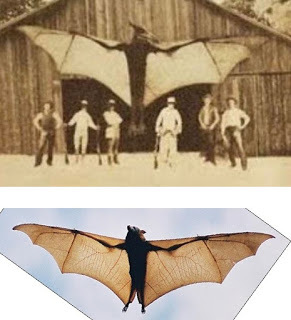 Fake thunderbird photo (top) and bat photo (bottom) (photo-manipulator(s) unknown to me / (© 945ontwerp/cdc.gov – reproduced here in low-resolution format on a strictly non-commercial Fair Use basis for educational/review purposes only)
Fake thunderbird photo (top) and bat photo (bottom) (photo-manipulator(s) unknown to me / (© 945ontwerp/cdc.gov – reproduced here in low-resolution format on a strictly non-commercial Fair Use basis for educational/review purposes only) I discovered that this bat photo had been snapped by a photographer with the screen name 945ontwerp, who had first uploaded it onto a Getty Images website named iStock on 5 June 2007 (please click hereto browse through his portfolio of spectacular photos available for purchase), but it has since appeared in numerous online publications. In particular, it opens an article written by Linda McIntosh and entitled 'Meet bats, creepy night critters' that appeared on the same day, 18 October 2016, in a number of different American newspapers, including the Chicago Tribune (click hereto access it) as well as the Morning Call, San Diego Union-Tribune, Baltimore Sun, and New York Daily News (and in which the photo, oddly, is credited to cdc.gov).
Finally: the feet of the bat in the bat photo do not match those of the thunderbird, indicating that a separate photographic source was used by the faker to yield these. Sure enough, while seeking the photographic source of the bat wings, I actually came across several different bat photos in each of which the depicted bat's feet were sufficiently similar to those of the thunderbird that some only very minor digital modification and enlargement would be needed in order to create the latter appendages. Incidentally, after some consideration I decided not to expend any additional time on this photo, as would be required were I to seek out the original image sources for the men standing in front of the thunderbird, because as can clearly be seen here, I have already presented more than sufficient evidence to confirm that this photo is a fake. However, if anyone reading this ShukerNature blog article of mine does have the time and the patience to do so, I'd certainly be very interested to learn if you succeed in tracing them online.
Another cryptozoological fake conclusively exposed, Case solved.
My sincere thanks to Randi MacDonald/Mosasaur for kindly bringing this fake thunderbird photograph to my attention.
An extensive documentation of alleged modern-day sightings and encounters with thunderbirds can be found in my book Still In Search Of Prehistoric Survivors.
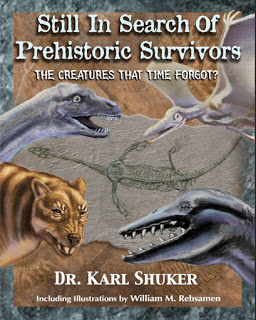 Still In Search Of Prehistoric Survivors
(© Dr Karl Shuker/Coachwhip Publications)
Still In Search Of Prehistoric Survivors
(© Dr Karl Shuker/Coachwhip Publications)
October 11, 2020
BOOK SOME TIME WITH MY NEW BLOG, 'SHUKER'S LITERARY LIKINGS' - A BLOG FOR FICTION FANCIERS AND FANCY FICTION!
 Shuker's Literary Likings (public domain)
Shuker's Literary Likings (public domain)As an incorrigible bibliophile, I've always been an avid reader of both non-fiction and fiction, the latter genre being the subject of this newest blog of mine - Shuker's Literary Likings , a blog for fiction fanciers and fancy fiction! Yet whereas in my recently-launched film blog Shuker In MovieLand I actively review movies (as well as the occasional TV show), I shall be using Shuker's Literary Likings (or SLL for short) more as a cyber-showcase for novels and compilations that I have enjoyed and can heartily recommend to other fiction fanciers.
I shall be illustrating each such book with the specific edition(s) of it that I have owned/read, presenting its official blurb when available, and sometimes adding comments of my own where relevant, as well as any interesting, pertinent trivia that I may chance upon. And, not surprisingly, there will be a goodly number of works featuring a cryptozoological theme included!
 Getting inside a good book could inspire you to write your own! (public domain)
Getting inside a good book could inspire you to write your own! (public domain)So, without further ado, I enthusiastically invite you to click here to visit Shuker's Literary Likings whenever you have some spare time, and browse my virtual library of novels and novellas, short stories and lengthy anthologies – a library that never closes or penalises you for keeping a book too long.
And who can say, perhaps you may find among its diverse multitude of enticing volumes that one special book which – knowingly or even unknowingly – you have been searching for your entire life. Stranger things have certainly happened, that's for sure!

September 22, 2020
A MISSING LINK DOUBLE-BILL - SAME TITLE, TWO VERY DIFFERENT CRYPTOZOOLOGY-LINKED MOVIES!
 Publicity poster for Missing Link (1988) and front cover of official DVD for Missing Link (2019) (© David and Carol Hughes/Universal Pictures; (© Chris Butler/Annapurna Pictures/Laika/Universal Artists/AGC – both images are reproduced here on a strictly non-commercial Fair Use basis for educational/review purposes only)
Publicity poster for Missing Link (1988) and front cover of official DVD for Missing Link (2019) (© David and Carol Hughes/Universal Pictures; (© Chris Butler/Annapurna Pictures/Laika/Universal Artists/AGC – both images are reproduced here on a strictly non-commercial Fair Use basis for educational/review purposes only)Today, ShukerNature reviews two cryptozoology-themed movies with the same title – Missing Link – but dramatically different formats and approaches, as will be seen.
MISSING LINK (1988)
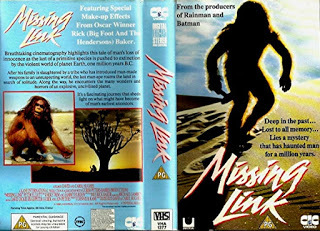 The full cover for the official VHS videocassette of Missing Link, the live-action movie released in 1988 (© David and Carol Hughes/Universal Pictures – reproduced here on a strictly non-commercial Fair Use basis for educational/review purposes only)
The full cover for the official VHS videocassette of Missing Link, the live-action movie released in 1988 (© David and Carol Hughes/Universal Pictures – reproduced here on a strictly non-commercial Fair Use basis for educational/review purposes only)Directed and written by David and Carol Hughes, Missing Link is produced in the style of a wildlife documentary with a voiceover narration by actor Michael Gambon. It is set in Africa one million years ago, and follows a voyage of discovery across this continent by a lone adult male 'man-ape' belonging to the early hominin species Australopithecus robustus. He is seeking others of his own species after having fled from the direct ancestors of ours, Homo sapiens, when his entire family was viciously slaughtered by them, leaving him as the only remaining representative of his species in that area.
This very unusual movie is more than a little reminiscent of another one that I watched and reviewed here on ShukerNature not long ago, Jonathan Livingston Seagull , in that although there is not a great deal of plot, the cinematography (again the work of the Hugheses) is absolutely spectacular. Missing Link was filmed on location in various Namibian national parks filled with iconic African fauna such as lions, elephants, giraffes, gazelles, zebras, mongooses, wildebeests, and those veritable avian locusts the red-billed queleas, whose immense flocks swarm and swirl through the sky like living composite super-organisms.
The unnamed australopithecine is played by Peter Elliott, and the fur suit as well as the constructed head and face that transform him into the man-ape are very impressive indeed. Viewing this movie constantly reminded me of the much later TV documentary series Walking With Cavemen (first screened in 2003, it was a successor to the highly successful, ground-breaking Walking With Dinosaurs and Walking with Beasts series).
 This memorable movie's unnamed, unconventional star – a lone surviving australopithecine ape-man (© David and Carol Hughes/Universal Pictures – reproduced here on a strictly non-commercial Fair Use basis for educational/review purposes only)
This memorable movie's unnamed, unconventional star – a lone surviving australopithecine ape-man (© David and Carol Hughes/Universal Pictures – reproduced here on a strictly non-commercial Fair Use basis for educational/review purposes only)Certainly, Missing Link was indeed far ahead of its time, but its lack of any major storyline or dialogue (other than Gambon's occasional words) probably explained why it was not a commercial success when released, and why it is seemingly not available on DVD. (Following its cinema debut, it was released in VHS videocassette format, examples of which are occasionally listed for sale online, but these are usually quite pricey.)
This is a great shame, because Missing Link is very deserving of being seen, as a tragic testament to how our ancestors almost certainly contributed to these distant relatives' eventual extinction - unless the mysterious agogwe, séhité, kakundakari, and certain other diminutive hairy man-beasts reported across Africa in modern times are relict survivors?
Offering a taster of the dramatic wildlife vistas and compelling content of Missing Link, here is an official trailer for this very different but definitely must-watch movie.
MISSING LINK (2019)
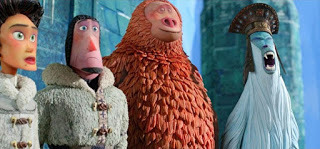 Photographic still for Missing Link, the animated feature film released in 2019, with Dora the Yeti Elder seen at far right (© Chris Butler/Annapurna Pictures/Laika/Universal Artists/AGC – reproduced here on a strictly non-commercial Fair Use basis for educational/review purposes only)
Photographic still for Missing Link, the animated feature film released in 2019, with Dora the Yeti Elder seen at far right (© Chris Butler/Annapurna Pictures/Laika/Universal Artists/AGC – reproduced here on a strictly non-commercial Fair Use basis for educational/review purposes only)Directed by Chris Butler, Missing Link is a delightfully droll animated crypto-classic originally released in early 2019, and tells the story of what is supposedly the very last sasquatch (a restrained but all the more hilarious vocal tour de force by Zach Galifianakis). Namely, a very sensitive male bigfoot named Susan (don't ask!), who hires adventurer Sir Lionel Frost (voiced with great aplomb by Hugh Jackman) to end his loneliness by transporting him to the Himalayas where he can be united with his nearest kin, the yetis. (Cryptozoological purists be warned: the yetis here are portrayed as having white fur, a traditional if mistaken representation, as according to local eyewitness reports these mystery man-beasts are actually brown- or red-furred.)
Along the way, they meet up with a former significant other of Sir Lionel, the feisty Adelina Fortnight (Zoe Saldana), and are pursued tenaciously by the evil henchmen of Frost's nemesis, the repressive, insane Lord Piggot-Dunceby (Stephen Fry). His obsessive goal is to prevent Frost's discovery of both Susan the bigfoot and the yetis of Shangri-La from ever becoming known to the world at large.
Speaking of which: my favourite character is the etiolated, secretive, and deliciously paranoid Yeti Elder, Dora, voiced with acerbic zeal by Emma Thompson. Also worth listening out for are Little Britain stars David Walliams as Lemuel Lint, Sir Lionel's former assistant, who barely escapes with his life from his ever-perilous role, and Matt Lucas as Mr Collick, the no-less neurotic assistant of Lord Piggot-Dunceby.
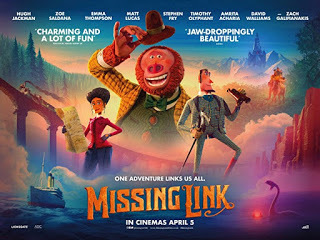 Publicity poster for Missing Link with the Loch Ness monster (© Chris Butler/Annapurna Pictures/Laika/Universal Artists/AGC – reproduced here on a strictly non-commercial Fair Use basis for educational/review purposes only)
Publicity poster for Missing Link with the Loch Ness monster (© Chris Butler/Annapurna Pictures/Laika/Universal Artists/AGC – reproduced here on a strictly non-commercial Fair Use basis for educational/review purposes only) Full of the dry, quip-driven humour that always appeals to me, but with a hefty dollop of good old-fashioned visual slapstick thrown in too, Missing Linkalso includes many spectacularly eyecatching scenes (one of which features fellow cryptid Nessie, the Loch Ness monster!), but none more so than the splendorous ice palaces and hidden valley of the yetis. Watching this charming movie is without a doubt a very enjoyable and highly entertaining way to pass a birthday evening, so that is precisely what I did on my most recent birthday.
To prove my assertion, here is a very funny official trailer for Missing Link – and here is another one!
A version of this double-bill review of cryptozoology-linked movies can also be accessed here on my Shuker In MovieLand blog.
September 18, 2020
DRAKE AND THE DRAGON - ON THE TRACK OF NEW GUINEA'S AWE-INSPIRING ARTRELLIA
 Is New Guinea home to gigantic monitor lizards? (© Dr Karl Shuker)
Is New Guinea home to gigantic monitor lizards? (© Dr Karl Shuker)The surname 'Drake' is derived from 'dragon'. Consequently, it is nothing if not appropriate that revealing a real-life dragon was one of the goals of 'Operation Drake'. This was a two-year-long international voyage of scientific discovery spanning 1978-1980, which was mounted by the Scientific Exploration Society and led by intrepid world explorer Lieutenant-Colonel (now Colonel) John Blashford-Snell, featuring a global team of Young Explorers (aged 17-24), and named in honour of the famous Elizabethan circumnavigator Sir Francis Drake. As for the sought-after dragon, this was the much-dreaded Papuan dragon or artrellia said to inhabit the jungles of New Guinea. But let us begin at the beginning of this modern-day search for a veritable medieval monster.
Since the end of the 19th Century, reports of gigantic, often tree-climbing reptiles have been emerging quite regularly from Papua New Guinea (PNG, but known prior to the end of World War II as Australian New Guinea). This is the country occupying the eastern half of New Guinea – a vast island mini-continent that boasts a land area of more than 300,000 square miles, and constitutes the world's second-largest island (only Greenland is larger). Said to be up to 30 ft, possibly even 40 ft, long (thereby far exceeding the length of even the biggest Komodo dragons – see later) and, in the case of mid-sized specimens, given to dropping down from overhanging branches onto unsuspecting creatures (and sometimes humans) walking by underneath, these 'dragons' are termed the artrellia by the New Guinea natives - who, understandably, live in considerable fear of these great beasts, and liken them to giant arboreal crocodiles or lizards. They have been given a number of local names, including the artrellia (also spelled variously as artrelia, atrela, otrelia, otrila, etc), the piako, and, in Neo-Melanesian Pidgin (Tok Pisin), the pukpuk bilong tri – a name that loosely translates as 'tree-climbing crocodile'. Many Westerners have also seen them.
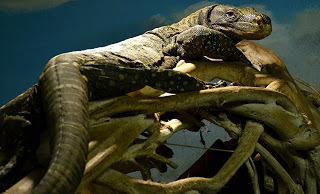 Some monitors are very adept arboreally (Wikipedia copyright-free image)
Some monitors are very adept arboreally (Wikipedia copyright-free image)During the three Archbold Expeditions of 1933-1939 to New Guinea, sent out by New York's American Museum of Natural History but financed and led by American zoologist and philanthropist Richard Archbold, the expedition members were consistently warned by their native helpers to beware of gigantic man-eating lizards that dwelt in the depths of this island's unexplored jungles.
In World War II, moreover, a number of British, American, Australian, and Japanese soldiers stationed in what would become PNG claimed to have spied huge lizards estimated at 15-20 ft long. Similarly, in 1960 David Marsh (at that time District Commissioner of Port Moresby, PNG's capital) stated that he had made two sightings of such reptiles during the early 1940s in western PNG. Also in 1960, two administration agricultural officers, Lindsay Green and Fred Kleckhan, succeeded in obtaining the skin and jawbone of a New Guinea 'dragon'; they had discovered these relics in a native village near Kairuku, 70 miles northwest of Port Moresby. Moreover, a report in Brisbane's Courier Mail newspaper for 22 January 1960 quoted PNG Patrol Officer Ian Gibbons as stating:
Wherever I have gone in the coastal districts of the territory where wallabies are common, I have found natives who know of these dragons. In several places I had natives do drawings of the dragons. The drawings were amazingly similar and looked very much like a photograph of the Komodo dragon.
 A Komodo dragon Varanus komodoensis, the world's largest lizard currently known by science to exist today © Dr Karl Shuker)
A Komodo dragon Varanus komodoensis, the world's largest lizard currently known by science to exist today © Dr Karl Shuker)Most exciting of all, and at the same time that these above-noted reports from 1960 were being publicised, Rachel Cleland - the wife of the then-Administrator at Port Moresby – claimed that in August 1959 she had actually seen a living specimen in captivity in the remote Daru district, during a visit to a mission station near Balimo, and that she had been told by a missionary there that the local natives had seen some 20-ft-long specimens. As far as I am aware, however, no photographs of the captive specimen were taken, nor any record documented of its fate (and that of its remains if it died in captivity rather than being released back into the wild at some point).
In 1961, explorers David George and Robert Grant encountered a giant lizard in the Strachan Island District of southern PNG. According to their description, it stood almost 4 ft high, was grey in colour, with a 3-ft-long neck, and a total length estimated by them to be approximately 26 ft. Not surprisingly, they kept their distance from this leviathanesque lizard, watching no doubt with great relief when it disappeared into the surrounding jungle.
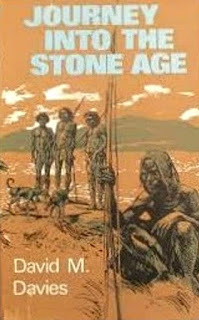 Journey Into The Stone Age
by David M. Davies (© David M. Davies/Robert Hale Ltd – reproduced here on a strictly non-commercial Fair Use basis for educational/review purposes only)
Journey Into The Stone Age
by David M. Davies (© David M. Davies/Robert Hale Ltd – reproduced here on a strictly non-commercial Fair Use basis for educational/review purposes only)The trail of the artrellia was evidently growing ever warmer, and fresh findings continued to be made as the years rolled by. In his book Journey Into The Stone Age (1969), traveller David M. Davies recalled being shown by some primitive valley-inhabiting PNG natives an unusual native drawing on a cave wall, which appeared to depict a huge lizard running on its hind legs, and of which his native companions were evidently very afraid:
The rain continued to pour down, and we noticed some scratches on the walls, so we turned our attention to these. We could make out some crude drawings of birds which showed that these people, like the Papuans outside the valley, had a bird complex. But there was also a queer creature drawn very large on the wall. It seemed to represent a huge lizard which was running on its hind legs. I remembered the reports of [Jim] Taylor and [Ivan] Champion, early explorers in Australian New Guinea [see below], who had seen these lizards and described them as very large and living in trees. On one of the expeditions Champion spoke of a local man who had been killed by such a lizard, which had dropped on to him from a tree. John (one of the missionaries) said he had heard something about them from the New Guineans themselves, but had never met anyone who had seen one. As we pointed at the drawing our hosts drew back, the whites of their eyes flashing. It seemed to be the only thing of which they were afraid.
Sent forth by Lieutenant Governor Hubert Murray to do the honours for his Papuan administration, during the late 1920s North-West Patrol Officers Ivan Champion and Charles Karius found fame by becoming the first white explorers to traverse New Guinea across its widest point, crossing from the headwaters of the Fly River to the Sepik River. After being thwarted by a seemingly impenetrable mountain wall on their first attempt, they successfully achieved this impressive navigational feat on their second, which concluded in 1928. Champion published full details of their epic journey, what they encountered, and all manner of interesting native testimony in his book Across New Guinea From the Fly to the Sepik (1932). As for explorer Jim Taylor, he famously led expeditions into Australian New Guinea's Highlands during the 1930s.
 Location of Fly River in PNG (© Roke/Wikipedia – CC BY-SA 3.0 licence)
Location of Fly River in PNG (© Roke/Wikipedia – CC BY-SA 3.0 licence)A major artrellia breakthrough occurred less than a decade after the 1969 publication of Davies's book when, in December 1978, news emerged concerning the successful filming three months earlier of a 2.8-m- (9-ft-) long New Guinea dragon by Jean Becker and Christian Meyer near the Fly River. Apparently, it was just one of a population of such creatures believed to exist in southern PNG, and which seemed to be monitor lizards. However, it was still not clear whether they constituted a new species.
That issue was finally resolved during the South Pacific phase of 'Operation Drake', via an expedition in December 1979/January 1980 to the PNG swamplands, led by Lieutenant-Colonel Blashford-Snell. As he subsequently documented in his book Mysteries: Encounters With the Unexplained (1983), he had heard numerous native stories of these enormous beasts, and was regaled with tales of their ferocity and the danger to anyone seeking to capture one of them. Notwithstanding this, he was so intrigued by these reports that he became determined to resolve this longstanding zoological mystery once and for all - by revealing conclusively both the reality and the zoological identity of New Guinea's fearsome dragon.
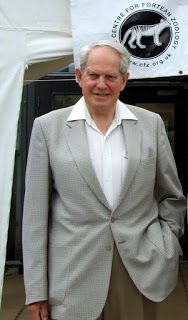 Lieutenant-Colonel Blashford-Snell (© Centre for Fortean Zoology)
Lieutenant-Colonel Blashford-Snell (© Centre for Fortean Zoology)Sadly, however, his expedition's attempts to achieve these goals consistently met with failure as the natives were very loathe to participate in the pursuit - until he resorted to an age-old but universally successful ploy. He bribed them! And sure enough, on 12 December 1979 in the coastal village of Masingara, west of Daru in PNG's Western Province, he was duly presented with a real-life artrellia, which had been shot by a villager but was still alive when brought back into camp. True, it was far from the 30-ft monster that the expedition team had been hoping for, measuring instead a mere 6 ft 1.5 in (which included a 4 ft-1.25-in tail). Nevertheless, the natives were still palpably nervous of this dying mini-dragon, and assured the team unhesitatingly that it was a genuine artrellia, albeit a very young one (on 11 January 1980 its formalin-preserved body was presented to PNG's National Museum in Port Moresby).
When it was examined by the team's zoologist, Ian Redmond (destined to become a world-renowned conservationist), he recognized its species straight away. It was a frequently arboreal lizard known zoologically as Varanus salvadorii, Salvadori's monitor (not to be confused - although it often is - with the similarly-named salvator monitor Varanus salvator). Moreover, he confirmed that this was indeed only a very young specimen - so to what size could fully-adult ones grow? Handsomely marked with black and gold spots, it was equipped with a fiery-colored flame-thrower facsimile for a tongue continually flicking in and out of its mouth in faithful homage to those conflagrating dragons of legend, and explaining Papuan native testimony that the artrellia breathes fire. Certainly, Salvadori's monitor is a visually impressive species and is known from fully-confirmed records to exceed 10 feet in total length quite regularly when adult, thereby making it the longest species of lizard alive today in the world.
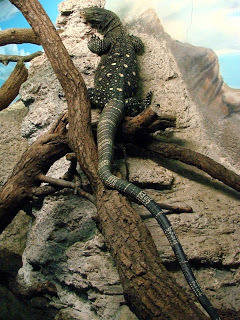 Salvadori's monitor (public domain)
Salvadori's monitor (public domain)Worth noting here, incidentally, is that the title of the world's longest species of lizard is often, but erroneously, ascribed to a famous relative of Salvadori's monitor - the Komodo dragon Varanus komodoensis, native to Komodo and a few other small Indonesian islands. In reality, however, the Komodo dragon is not the longest, because it rarely exceeds 10 ft - but it is the largest. The reason for this distinction is that whereas at least two-thirds of the total length of Salvadori's monitor consists of its very slender tail, the tail of the Komodo dragon only accounts for half of its total length - so the Komodo dragon is much sturdier and heavier than the more svelte, lightweight Salvadori's monitor.
Adding further support to this latter species being one and the same as the legendary artrellia, it has long been known that natives inhabiting the Fly River area of PNG commonly refer to Salvadori's monitor as the tree crocodile. It is the largest of the seven varanid species known to exist on New Guinea, and inhabits lowland forests as well as coastal mangrove swamps, but usually in fairly remote, largely inaccessible localities, making field studies of this impressive species difficult to undertake.
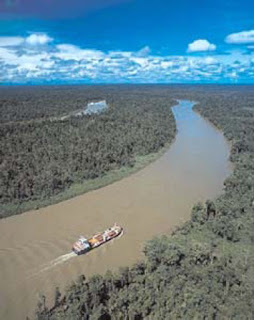 The Fly River (public domain)
The Fly River (public domain)Based upon the sizeable number of reports describing quite immense artrellias in New Guinea, it would seem that Salvadori's monitor can far exceed even the longest officially verified record for its species - that of 15 ft 7 in, recorded from a male specimen measured over 30 years ago by researcher Michael Pope. So far, however, no-one has captured a 30-ft or 40-ft artrellia (not even a 20-ft specimen, in fact), but sightings continue. In the more remote jungles and swamps of New Guinea (of which there are a very great many still in need of scientific investigation, not only in PNG but also in this vast island's western, Indonesian half - formerly known as Irian Jaya), which are little-frequented by native tribes and scarcely explored at all by Westerners, thereby constituting sanctuaries for larger forms of life, it is certainly not beyond the realms of possibility that extra-large artrellia specimens do indeed exist, undisturbed and free from human persecution.
During that same 'Operation Drake' expedition, Ian Redmond had a brief but direct face-to-face encounter with what may well have been a sizeable Salvadori's monitor. He was later interviewed on-screen concerning his experience for an episode of the very popular television series 'Arthur C. Clarke's Mysterious World' (first screened in 1980) that dealt with a wide range of mystery beasts from around the world (the episode in question was entitled 'Dragons, Dinosaurs and Giant Snakes'). Here is his verbatim account of that notable confrontation:
We were staking out water-holes, because the lizard has to come for water every day, and some of the water-holes are in a creek bed. So you're below the level of the forest floor, in a creek bed, by a pool. And one day, there were two of us, a few hundred yards apart - I was sitting by one pool, another chap by another pool. And I'd been sitting there for several hours, and nothing happening, it was about 10 o'clock in the morning. And I heard these footsteps. It's a forest floor, so there's lots of dry leaves on the floor. This is quiet, softly scrunching of dry leaves. Now, if you hear a lizard moving through the forest, it's a scurrying sound, it doesn't sound like footsteps. And I thought it must be either the other chap coming over - whether he was playing about and trying to sneak up on me, I didn't know. But it sounded very stealthy. So I was sitting down there, and I hear this coming up behind me. And obviously, you decide, at some point you've got to have a look. So, as they were getting closer, I thought: "Well, person or animal, I'm going to see what it is". So I slowly sat up and looked around. And about 10 ft away – my eyes were about on the level of the bank – about 10 ft away, there was a log, and just over the log was this great lizard head. Now, I couldn't see the whole body, but I could see that the head and shoulders were a lot lot bigger than the one which had been shot. So I went down for my camera again, and as I went down to get my camera the lizard moved away.
And here is the episode itself, currently uploaded and viewable on YouTube – Ian's interview begins at 13 min 30 sec into the video:
https://www.youtube.com/watch?v=fanU9...
I have known Ian for some years, and when I mentioned to him that I was preparing this article he very kindly sent me his unpublished field notes concerning the search by him and others during 'Operation Drake' for the artrellia, and he gave me full permission to cite anything from them in my article that I so wished – thank you very much, Ian! This has enabled me to incorporate a number of important details throughout this article that had not previously been publicly available, and I now have a specific date for Ian's famous sighting of the lizard head above the log – 16 December 1979. Moreover, in view of his sighting's great significance in the search for the artrellia, I feel that it would be very valuable and insightful to read Ian's account of it in his field notes for that date, especially as it includes some very interesting additional information not previously revealed, so here it is:
16th December 197910.00am: Sitting in creek bed beside small pool. Hear what sounds like the cautious step of a bare-foot human approaching from W (rear); slowly raise my head above bank and see at approx. 8-10m [possibly meant 8-10 ft, which would then correspond with his TV interview's 10-ft statement, or vice-versa?] the head and shoulders of an ATRELA – it freezes, I reach down for my camera but it moves away (not hurried, at the same pace) out of sight but not far. Nothing further heard – perhaps up tree? Seemed bigger than 6ft 1.5in specimen – perhaps 8ft? total length.
Round bend in creek bed, found firm clay pig wallow with tracks of large monitor, some complicated by overlying tracks of smaller one. Fore-foot tracks were 8-9cm long (not clear palm of hand) and 4cm wide; heels of hind-foot very clear (imprint of scales visible) and were 24cm apart (between centre of left heel to centre of right heel). Footprint minus toes was about 10.5cm by 5.5cm, and very clear length of outer toe to heel of left foot was 13cm. If the ratio of outer toe/foot length to total length of the 6ft 1.5in is the same as for this individual, it would be approx. 302-345cm total length.
The pool and creek bed featured in Ian's sighting were located just outside the village of Tati, which was a two-and-a half-hour walk northeast of Masingara, where the 6-ft-1.5-in specimen had been shot four days earlier.
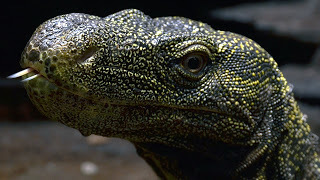 Close-up of the head of a Salvadori's monitor, revealing this species' characteristic bulbous snout (Wikipedia copyright-free image)
Close-up of the head of a Salvadori's monitor, revealing this species' characteristic bulbous snout (Wikipedia copyright-free image)Local reports often claim that the artrellia will sometimes rise up onto its hind legs, and that in this position big specimens can stand 10 ft tall, looking positively dinosaurian in appearance. On 1 January 1980, Ian had been walking back to Masingara from the village of Giringorede with a native hunter named Buwae Gire. In the Giringorede dialect, the artrellia is known as the piako, and Gire informed Ian that an old man had actually sat on top of one such beast, having mistaken it for a fallen tree trunk until it moved and then abruptly reared up onto its hind legs. The piako didn't attack him, but not surprisingly he fled away in terror.In his field notes for that day, Ian recorded the following additional information given to him by Gire:
[The old man] estimated its length to be 12 paces (he [Gire] paced the length for me) – i.e. about 36 ft.
Biggest one seen by Buwae himself was about 16 feet (I measured the distance along the ground indicated by him). He sometimes eats smaller ones; they are quite common in the area – while walking he would expect to see one every hour or hour and a half. They eat animals that they catch by jumping from a tree. I asked if he had ever seen this, and he said yes. I asked him what the lizard caught on that occasion, and he replied, “One of my hunting dogs!” This had the ring of truth about it, and I saw no reason to doubt his observations.
As recorded by a number of herpetological observers and researchers down through the years, including John Netherton and David P. Badger in their book Lizards: A Natural History of Some Uncommon Creatures (2002), it is well known that some species of monitor – including Salvadori's – will indeed raise themselves up like this to scrutinize their surroundings. They can even briefly run bipedally too, on their hind legs alone, should the need arise. Such behaviour could also explain the cave drawing reported by David M. Davies.
 Artistic representation of an au angi angi (© William M. Rebsamen)
Artistic representation of an au angi angi (© William M. Rebsamen)Finally: Another mystery monitor reported from New Guinea but far less familiar, cryptozoologically speaking, than the artrellia is the au angi angi. Whereas the artrellia is said to be terrestrial and arboreal, the au angi angi is reputedly amphibious, a freshwater form inhabiting a number of swamps and rivers, and allegedly measuring up to 27 ft long, thereby indicating that there could be exceptionally large specimens of water monitor still awaiting verification on this mini-island continent too. Moreover, along the banks of New Guinea's Casurina coast is said to live a monstrous form of lizard larger than the Komodo dragon and known by the natives of that region as the cuscus (but not to be confused with the possum-related New Guinea – and Australian – marsupials of that same name).
Over the years, I've noted on a number of occasions that just like most things, mystery beasts have a tendency to go in and out of fashion. At present, the artrellia seems to be one that is very much out of fashion, inasmuch as it rarely rates a mention in surveys of mystery creatures even of passing interest to cryptozoologists, let alone ones that are actively being sought by them in the field. This may be due to the revelation by the 'Operation Drake' team that the artrellia belongs to a species already known to science, with the attendant implication that seeking it further is therefore no longer of cryptozoological –or even of mainstream zoological – interest.
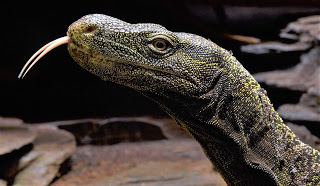 Head and neck of an adult Salvadori's monitor – a veritable dragon of Papua? (copyright-free Wikipedia image)
Head and neck of an adult Salvadori's monitor – a veritable dragon of Papua? (copyright-free Wikipedia image)Yet if native testimony is to be believed (and the capture of the young artrellia in December 1979 confirmed that such a creature did indeed exist and was not merely a myth), there are huge artrellia specimens still out there in the jungles and swamplands of New Guinea awaiting formal confirmation of their reality – a reality that may in turn affirm that the Komodo dragon is not the largest living species of lizard after all, that instead we should be handing over this longstanding record to some truly gargantuan Salvadori's monitors instead. That should be exciting enough, surely, to warrant new quests for such goliaths of the reptile world. Then again, that may perhaps equally explain at least some of the reluctance to go forth in search of them. After all, to seek veritable dragons, we need a literal St George, or at least a modern-day Sir Francis Drake, and such brave, determined heroes may well be as difficult to locate in today's unadventurous times as the dragons themselves!
I wish to offer my very sincere thanks to Ian Redmond for sharing with me and permitting me to utilize for this article his field notes from the 'Operation Drake' PNG expedition as well as an unpublished paper incorporating them that he co-authored with the late Mark K. Bayless. Mark was an extremely knowledgeable herpetoculturist from California who was also a longstanding friend of mine, having swapped a considerable amount of cryptozoological information with me down through the years relating to herpetology, and whose untimely death in November 2006 at the age of only 46 devastated me. RIP Mark, you are greatly missed, and I am dedicating this ShukerNature blog article of mine to your memory.
POSTSCRIPT – 10 September 2020
Today I received the following fascinating email from Jordan Beck who as a missionary's son has lived and grown up among the tribal people in Indonesian New Guinea (the western half of New Guinea). Here is the very intriguing information contained in his email to me:
Hi I recently read you article Drake and the Dragon [a hard copy version of this online ShukerNature blog article] and I was really fascinated by it. I am a missionary kid in Papua Indonesia and I live in the lowland swamps. Our tribal people have stories of lizards that eat people, boars and cassowaries. When I showed them your article they all pointed to the Komodo Dragon and said that's the lizard that eats people. When I asked them if they had seen it they all said that they had and they said if you see them run. When I asked them how big they get they said roughly a size of 15-19 ft. When I showed them the Croc monitor [Salvadori's monitor] they said the large man eating lizard was black like the Komodo Dragon not spotted. On another account we were up river on a[n] adventure and on the beach I found 6 inches wide monitor foot prints in the sand [-] when I showed our guide he told us that those were the foot prints of the large man eating lizards and that we should keep a careful watch on the surrounding jungle.
Could it be that there is an extra-large version of Salvadori's monitor inhabiting this section of New Guinea that is not spotted? Such a lizard would superficially resemble the Komodo dragon, and therefore explain why the New Guinea tribal people questioned by Jordan selected photos of this latter non-native species as resembling the dreaded man-eating giant lizards claimed by them to exist here.
 Alongside a life-sized Komodo dragon model (© Dr Karl Shuker)
Alongside a life-sized Komodo dragon model (© Dr Karl Shuker)Karl Shuker's Blog
- Karl Shuker's profile
- 45 followers



